The Nanofish Encyclopaedia
Table of contents
- Minimum aquarium size
- Which aquarium shape?
- Alternative to fish
- Nanofish up to 5 cm body length
- Labyrinth fish
- Colisa chuna - honey gourami, golden honey gourami
- Trichopsis pumilus - growling dwarf gourami
- Betta splendens - fighting fish
- Darters
- Heterandria formosa - Dwarf carps
- Neoheterandria elegans - teddy bear fish
- Poecilia wingei - Endler's guppy
- Garfish
- Spikefish-like
- Pseudomugil gertrudae - Spotted blue-eye
- Iriatherina werneri - Filigree rainbowfish, splendid rainbowfish
- Bearblings
- Boraras brigittae - Mosquito rasbora
- Boraras maculatus - Dwarf danio
- Boraras merah - gold-spotted dwarf danio
- Boraras naevus - strawberry dwarf danio
- Boraras urophthalmoides - tail stripe rasbora
- Brachydanio rerio "long fin" - Veil zebra danio
- Brachydanio rerio var. frankei "long fin" - veil Leopard danio
- Brevibora dorsiocellata macrophthalma (Rasbora dorsiocellata macrophthalma) - Glow-eyed danios
- Danio erythromicron - Cross-striped dwarf danio
- Danio margaritatus - guinea fowl danio
- Microdevario kubotai - Green Neon Dwarf Grassbora
- Rasbora borapetensis - red-tailed danio, red-tailed rasbora
- Rasbora heteromorpha - Wedge-spotted barbel
- Tanichthys albonubes - Cardinalfish / Veil Cardinalfish
- Trigonostigma espei - Espes wedge-spotted danio
- Barbels
- Oliotius oligolepis (Puntius oligolepis) - Eiland barb, mother-of-pearl barb
- Puntius titteya - bitterling barb
- Fouling catfish
- Corydoras
- Corydoras hastatus - Sickle-spotted armoured catfish
- Corydoras pygmaeus - dwarf armoured catfish
- Corydoras panda - Panda catfish
- Tetra
- Aphyocharax anisitsi - red fin tetra
- Carnegiella marthae - blackwing hatchetfish
- Hasemania nana - copper tetra
- Hemigrammus bleheri - red-headed tetra
- Hemigrammus erythrozonus - glow tetra
- Hemigrammus ocellifer - lantern tetra, taillight tetra
- Hemigrammus rubrostriatus - Red stripe tetra
- Hyphessobrycon amandae - sparkle tetra
- Hyphessobrycon amapaensis - Amapa glow tetra
- Hyphessobrycon bentosi - jewel tetra, crescent tetra
- Hyphessobrycon serpae - blood tetra, serpae tetra
- Hyphessobrycon flammeus - Red from Rio
- Hyphessobrycon herbertaxelrodi - black neon tetra
- Hyphessobrycon piranga - Red Devil, Red Devil
- Hyphessobrycon pulchripinnis - Lemon Tetra, Fairfin Tetra
- Hyphessobrycon megalopterus - Black Phantom Tetra
- Inpaichthys kerri - king tetra
- Knodus borki - Blue perusal tetra
- Nannostomus marginatus - Dwarf tetra
- Nematobrycon palmeri - Emperor tetra
- Paracheirodon axelrodi - Red neon tetra
- Paracheirodon innesi - Neon tetra gold
- Paracheirodon simulans - Blue tetra
- Pristella maxillaris - Star-spotted tetra
- Gobies
- Pufferfish
Minimum size of aquariums
In principle, there is no minimum size prescribed by law in Germany for keeping ornamental fish, but the recommendations of the Federal Ministry of Food and Agriculture (BMEL), the Minimum Requirements for the Keeping of Ornamental Fish in Freshwater of 1998, apply here as guidelines. Here, an aquarium size of 54 litres or 60 cm in length is recommended for permanent keeping; the minimum requirements make an exception for particularly small fish. However, this does not mean that you can cram every tiny fish into a nano tank - the behaviour of the little ones is decisive! And most of the so-called nano fish are quite happy to swim and give it their all on the long side of the aquarium. Cramming them into a nanocube would not really suit their nature. You should therefore take a close look at the individual species so that you can meet their needs.
In Austria, on the other hand, the permanent keeping of fish in aquariums smaller than 54 litres is even prohibited by law - here, therefore, this question does not arise at all.
Nano aquariums(shop)
In freshwater aquaristics, all tanks from 5 to approx. 54 litres are considered nano aquariums. However, it should be clear to every animal lover that keeping fish in 5 litres is self-explanatory. Fish keeping (where it is permitted) usually begins in aquariums of 25 litres or more for particularly small species that do not swim very well. Please note that fish have a more active metabolism than shrimp, for example, and that the small water volume makes a nano aquarium prone to mistakes. So here you need to keep a good handle on water changes and also feeding, so that the animals always have animal-friendly, clean water available.
Which aquarium shape?
Basically, in rectangular tanks the fish have considerably more swimming space than in cube-shaped aquariums, despite the same volume. A relatively narrow, but long aquarium with a capacity of 25-30 litres can therefore be well suited even for species that like to swim a little, but would have to lead a rather dull life in a cube-shaped tank.
Alternative to fish
If you would prefer not to (or are not allowed to) keep fish in nano aquariums, you always have the alternative of using shrimps. Some aquarium snails can also be kept in smaller tanks, as can a few dwarf crayfish that stay small, either as individuals or - if well structured - in pairs.
Nanofish up to 5 cm body length
In the following, we would like to introduce some fish that fall into the category of "nano fish" because of their small body size. However, not all of them fit into small aquariums of 60 cm edge length - if the fish need more space, we have noted this. Of course, there are many, many more species of fish that stay small, but we will limit ourselves here to the best-known and most popular aquarium fish.
Labyrinth fish
Besides the very well-known fighting fish, the group of labyrinth fish also includes the gouramis or threadfish. Their most outstanding feature is that, in addition to their usually only rudimentary gills, they have a labyrinth organ with which they can breathe oxygen from the air. Labyrinth fish therefore always need free access to the water surface in the aquarium! Since labyrinth fish can actually catch cold in cool air (and besides, they are usually quite active fish that also jump a lot), the aquarium should always be well covered. Most labyrinth fish breed in foam nests built by the males. They are carnivores. The most popular labyrinth fish in aquariums mainly eat insects, insect larvae, small crustaceans and other small animal aquatic creatures.
Colisa chuna - Honey gourami(Shop), Golden honey gourami(Shop)
There is a golden-coloured version of the honey gourami, which has the same requirements for the aquarium and only differs in colouring from the honey gourami. The labyrinth fish breathe air and therefore always need access to the water surface. The long tactile filaments that the pectoral fins have been transformed into are striking. The labyrinth fish build a foam nest for reproduction, the males engage in brood care. Carnivores. The males are much more colourful than the females. Keep in pairs. Water values: GH 10-20 °dGH, KH 0-8 °dKH, pH 6.5-7.2, temperature 22-28 °C.
Trichopsis pumilus - Growling Dwarf Gurami(Shop)
This very small labyrinth fish grows to only 3-4 cm, which definitely makes it a nano fish. As a group fish it is kept in a shoal. Breeding is not difficult in a species tank. Very territorial during the breeding season. A socialisation with shrimps works only to a very limited extent. Amano shrimps, for example, are suitable. Water values: GH 6-18, KH 0-10, pH 5.5-6.5, temperature 25-29 °C.
Fighting fish (Betta splendens)(Shop)
A real nano fish, i.e. a fish that can be kept in a nano aquarium of 20-50 litres, is the fighting fish Betta splendens, despite its size. Especially the long-finned cultivated forms are not good swimmers and certainly not lively swimmers. Fighting fish are very aggressive within the species and should therefore best be kept singly. Stress has a life-shortening effect on bettas. A single Betta splendens can be kept perfectly in a small, very well planted aquarium such as a Dennerle Cube of 30 l capacity. Fighting fish are labyrinth fish and always need free access to the water surface, even though they like shading by floating plants very much. As they jump, the aquarium should be well covered. Fighting fish come from Thailand and Cambodia in Southeast Asia. They can live for about 3 years. Betta splendens are hunters. Socialising with shrimps can go well, but it depends on the character of the fish - some fighting fish hunt intensively and in such aquariums no shrimp will survive in the long run. Fighting fish are carnivores and should not be fed with normal flake food. Special food for carnivorous fighting fish, live food or frozen food are definitely the better choice here. Betta splendens prefer a weak current, soft to hard water and they need a temperature of 22-26 °C.
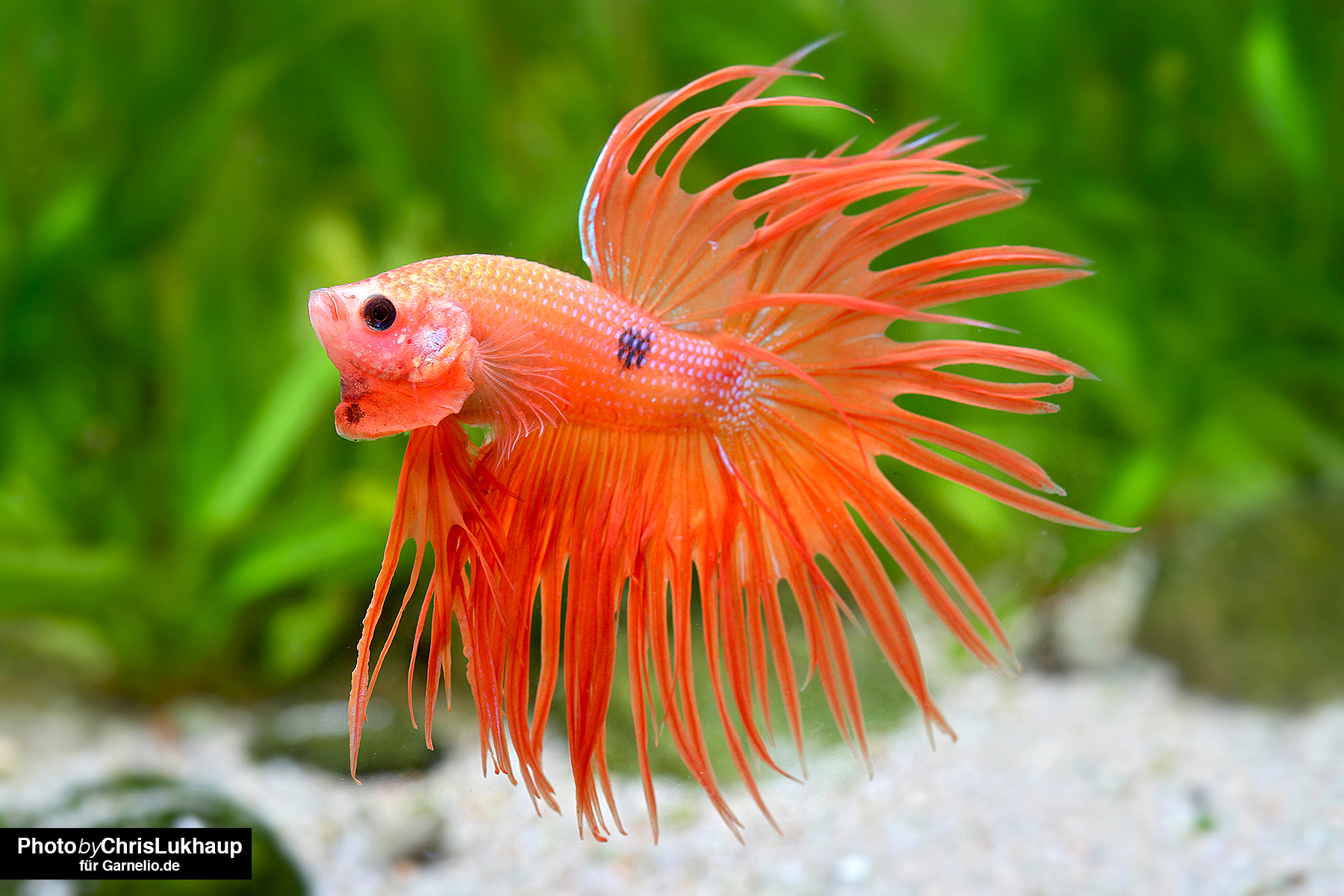
Bettas splendens
Some carps are also not long-distance swimmers, but are quite sedentary and therefore also suitable for keeping in smaller aquariums. They usually come from weedy waters. Many Carps are group fish and therefore want the company of at least 10 conspecifics in the aquarium. Most carps are omnivorous and are happy to eat fine flake food as well as small live foods or frozen foods that they can handle with their small mouths. Live-bearing toothcarps also belong to the group of carps - breeding them in the aquarium is then particularly easy. In the following, we introduce species that fit well into smaller aquariums due to their site fidelity.
Heterandria formosa - Dwarf Carp(Shop)
From the south of the USA. 2-3.5 cm in size, fits very well into smaller, well planted aquariums from 25 l. Loyal to habitat. Livebearer, easy to breed. May eat very small shrimp babies. Water values: GH 10-20, KH 5-15, pH 7-8, temperature 13-22 °C.
Neoheterandria elegans - teddy bear fish
From Colombia / South America. Only 2.5 cm in size, calm fish, good for small planted aquariums from 25-30 l. Livebearer, easy to breed. Best in a species tank or with shrimps like Neocaridina. Water values: GH 5-15, KH 3-12, pH 6.5-7.5, temperature 23-27 °C.
Poecilia wingei - Endlers Guppy(Shop)
From South America. The male Endlers grow only about 2.5 cm long, the females about 4 cm. Breeds extremely well, live-bearing. Goes to young shrimps, therefore only to well reproducing species like Neocaridina davidi and relatives. Assertive small fish that can be socialised well. Water values: GH 10 to 25, KH 5-20, pH 7 to 8.5, temperature 22 to 28 °C.
The Endler Guppy Poecilia wingei is available in other very interesting colours, such as the Green Tiger Endler(Shop) or the Japan Blue mix Endler(Shop).
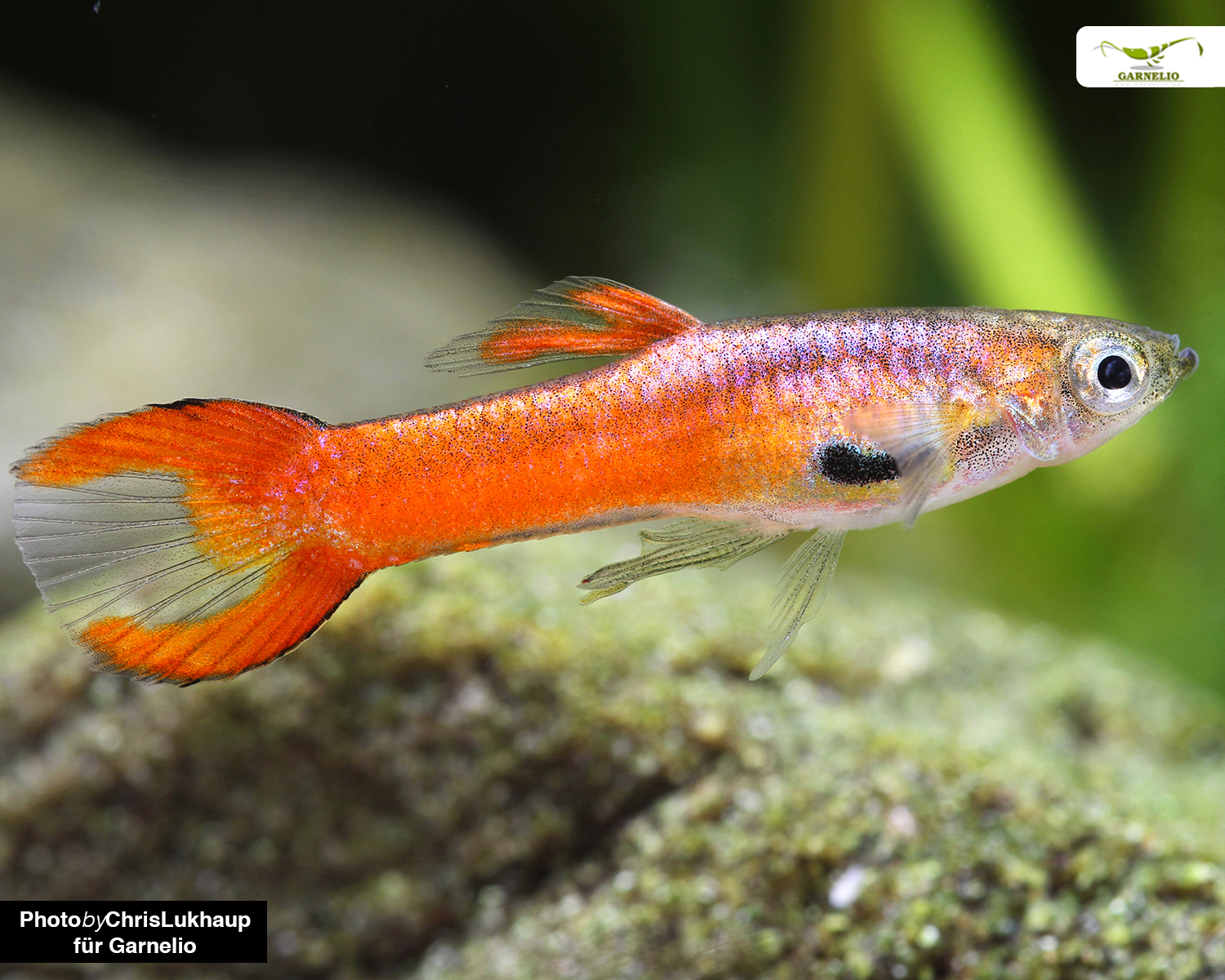
Horned Pike
The fish in this group - half-beaked and garfish - are anything but small, but this group also includes the rice fish, which at 3-5 cm are small enough to pass as nano fish. These small representatives already fit into aquariums with a capacity of 54 litres or more. The garfish or Beloniformes are bony fish. Their upper jaw is rigid - a special feature of this family. Without exception, the garfish are carnivores that feed only on animal food. This should be taken into account when keeping them in an aquarium. They can be kept in soft to medium-hard water without any problems. The garfishes are a sister group of the toothfishes, so rice fishes and co. are very distantly related to guppies, kilifishes and so on. However, they do not belong to the same order, even though they are sometimes mistakenly counted among the Cypridnodontiformes.
Oryzias cf. woworae - Neon Ricefish
From the island of Sulawesi. Up to 5 cm in size, very peaceful and rather reserved aquarium fish, which must be kept in a group. Very small mouth, therefore good to keep together with dwarf shrimps. Adhesive spawners, the females carry their spawn clusters around on their abdomen for some time. Breeding is relatively easy. Related to the popular Medaka. Water values: GH up to 15, KH up to 10, pH 6-7.5, temperature 22-26 °C.
Spikefish
The spikefishes belong to the bony fishes and usually remain quite small. Some species are very colourful and beautiful to look at. They can be kept well in the aquarium, and some of them belong to the nanofishes. The bony fish live mainly in the subtropics and in the tropics in freshwater. They are group fish and should therefore not be kept alone. However, as omnivores they are happy to eat fine live food from time to time.
Pseudomugil gertrudae - Spotted Blueeye(Shop)
From Indonesia. Up to 3 cm in size, lively, "fluttering" fish, very peaceful - the butterfly among aquarium fish. Schooling fish. Very small mouth, very good company with dwarf shrimps, usually does not chase them. Egg-layers, not easy to breed. Water values: GH 2-20, KH 0-6, pH 6-7, temperature 24-27 °C.
Iriatherina werneri - Filigree Rainbowfish, Magnificent Rainbowfish(Shop)
From Australia and Papua New Guinea. Males up to 5 cm, females somewhat smaller. Very splendidly coloured, very peaceful filigree schooling fish with interesting body shape and fascinating swimming behaviour. Mating play is particularly impressive and reminiscent of dancing butterflies. Egg-layers, adhesive spawners. Breeding possible. Water values: GH up to 10, KH 0-6, pH 6-7, temperature 24-26 °C.
Dwarf danios
The danios also belong to the extensive family of carp fish. Many danios remain very small, so they are often sold as nano fish. Classically, they are group fish that come together to form a shoal, especially in stressful situations. They should always be kept in groups of about 10 or more. These great little, usually quite lively aquarium fish look particularly beautiful in a larger shoal in a suitably large aquarium. You should not go below 50-60 cm edge length. Most danios are omnivores with a slight emphasis on animal food, they are extremely grateful for live food and also for small frozen food in addition to conventional flake food or granulated food of appropriate size. With very small species, of course, the food must also be appropriately fine.
With a few exceptions, it is not quite so easy to breed bearbellies because most species need very soft, clean and relatively acidic water with a high humic content for reproduction and because the adult fish find spawn - even their own - quite tasty. For breeding these nano fish you therefore need a separate breeding tank.
Boraras brigittae - Mosquitorasbora(Shop)
From the island of Borneo in Southeast Asia. Intense red coloured mini fish with a body length of only 2-3 cm, fits well in small but long aquariums. Lively and sociable. From soft water biotopes, therefore ideal as company for dwarf shrimps such as bee shrimps and co. which also need soft water. Shrimp babies do not fit into the tiny mouth. Socialisation with other mini fish possible, breeding difficult. Water values: GH 3 to 10, KH 0 to 6, pH 6 to 7, temperature 24 to 28 °C.

Boraras maculatus - Dwarf Dwarf(Shop)
Comes from the island of Sumatra in Southeast Asia. Grows to only about 2-3 cm in size and is therefore well suited for small tanks, but likes to show its playful behaviour over longer distances and should therefore not be kept in aquariums with an edge length of less than 60 cm. Needs soft water, goes well with bee shrimp and other soft water shrimp. Due to its small size harmless for shrimp babies. Socialisation with other very small fish possible. Breeding difficult. Water values: GH 3 to 10, KH 0 to 6, pH 6 to 7, temperature 24 to 28 °C.

Boraras merah - gold spotted dwarf danio(shop)
From the Southeast Asian island of Borneo. Also grows to only 2-3 cm and fits very well into smaller aquariums. Can also be kept in soft water, best suited for socialising with shrimps from soft water habitats and with other fish of comparable size, does not eat shrimp babies. Breeding difficult. Water values: GH 3 to 10, KH 0 to 6, pH 6 to 7, temperature 24 to 28 °C.
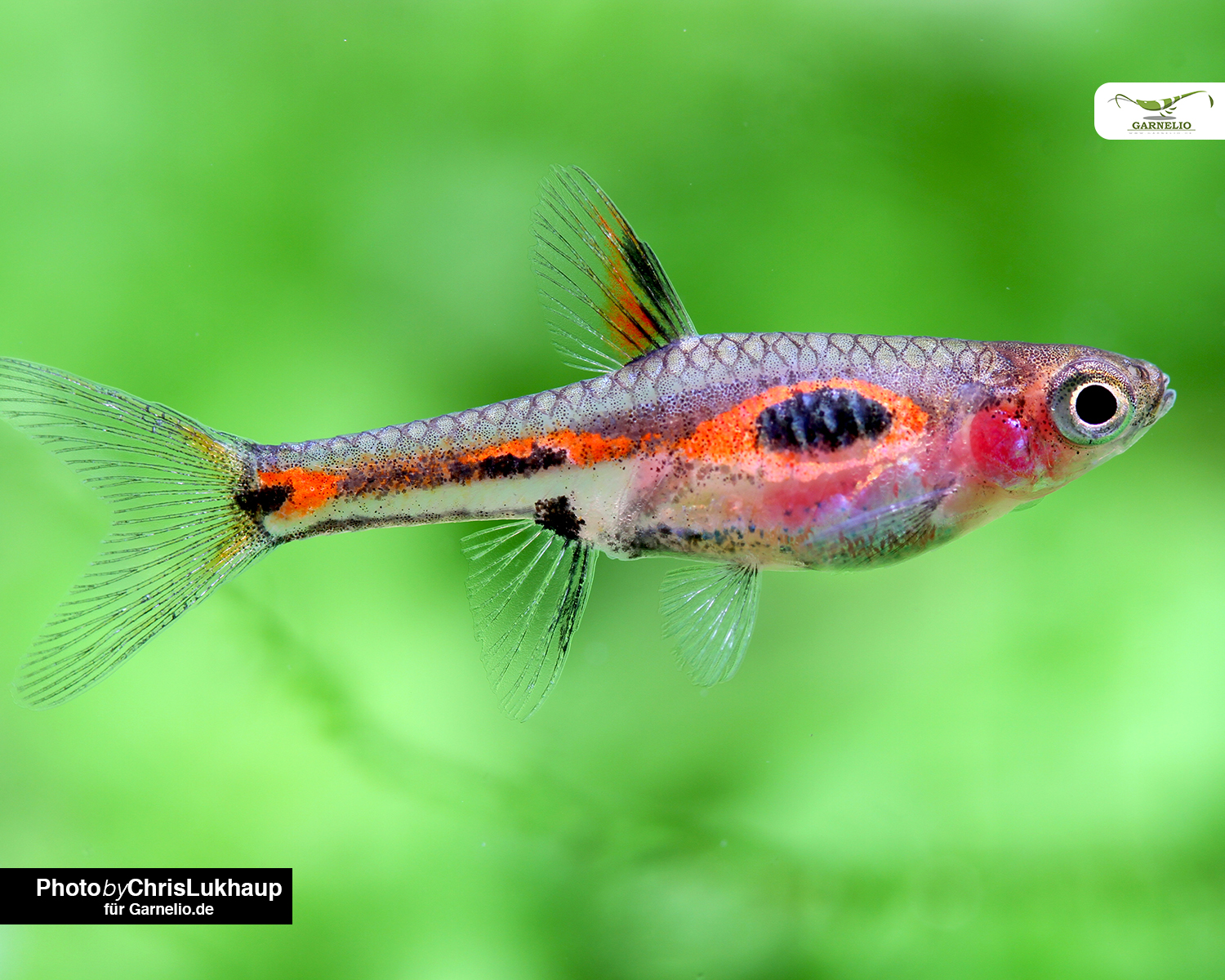
Boraras naevus - Strawberry Dwarf Dwarf(Shop)
From soft water habitats in Thailand / Southeast Asia. Lively and eager to swim, therefore only in aquariums from 60 cm. With 1.5-2.5 cm really very small, therefore optimal with soft water shrimps like bee shrimps or taiwan shrimps or with other very small fish. Breeding difficult. Water values: GH 3 to 10, KH 0 to 5, pH 5 to 7.5, temperature 22 to 26 °C.
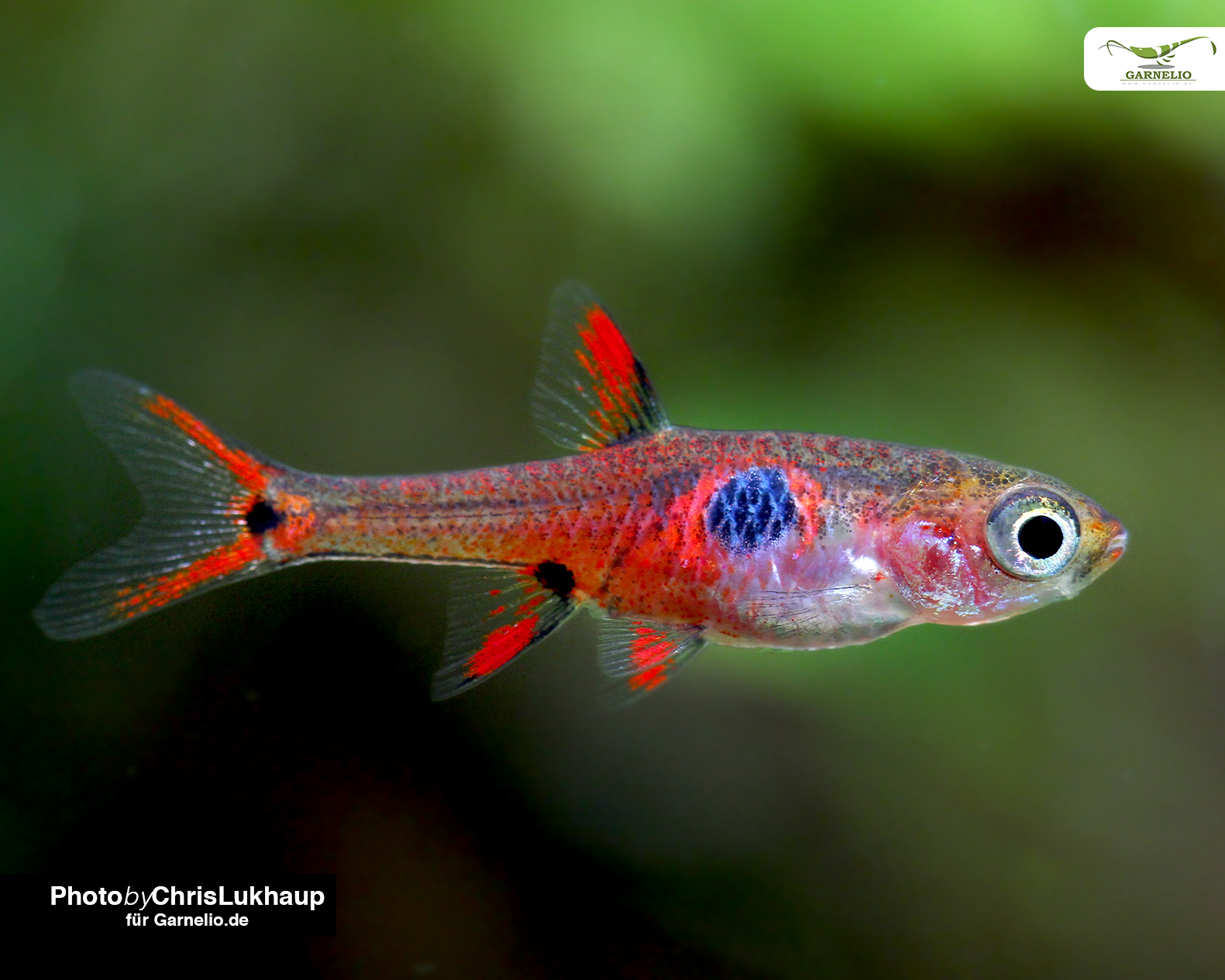
Boraras urophthalmoides - tail stripe rasbora(shop)
From Southeast Asia. Grows to only about 2.5 cm and needs soft water, therefore fits very well with bee shrimp and other soft water shrimp. Does not eat shrimp offspring. Good to keep together with other small fish. Breeding difficult. Water values: GH 3 to 10, KH 0 to 5, pH 5 to 7.5, temperature 22 to 26 °C.

Brachydanio rerio "long fin" - Veiled Zebra Fin(Shop)
The Veil Zebrafish is a long-finned variety of the lively striped Zebrafish from India, Bangladesh and Nepal. From 80 cm. It can be kept with shrimps and dwarf crabs and is considered to be extremely frugal. Omnivorous, schooling fish. Water values: GH 10-30, KH 8-15, pH 6.5-8.5, temperature 24-27°C.
Brachydanio rerio var. frankei "long fin" - Veiled Leopard Fin(Shop)
The Veil Leopard Fin is probably a long-finned variety of the lively Leopard Fin. It is suitable for keeping with shrimps and dwarf crayfish and is considered to be extremely adaptable. Omnivorous, schooling fish. Water values: GH 10-30, KH 8-15, pH 6.5-8.5, temperature 24-27°C.
Brevibora dorsiocellata macrophthalma (Rasbora dorsiocellata macrophthalma) - Glow-eyed danio(Shop)
The luminous eye danio with the long scientific name is a small fish that likes to swim. Its colouring shows elegant understatement and it fits perfectly into green planted aquariums. It can be kept with shrimps. Omnivorous, schooling fish. From 54 litres. Water values: GH 5 to 10, KH 0 to 6, pH 5.5 to 7.5, temperature 24 to 25 °C.
Danio erythromicron - cross-striped dwarf danio(Shop)
From Burma. Grows up to 3 cm long, needs rather hard water and can be bred in the aquarium (even if in small numbers). Good with proliferating shrimps like Neocaridina, may eat shrimp offspring. Omnivorous, happy to eat small live food up to about the size of a black mosquito larva. Group fish. Water values: GH 5 to 20, KH 3 to 18, pH 7 to 8, temperature 18 to 25 °C.
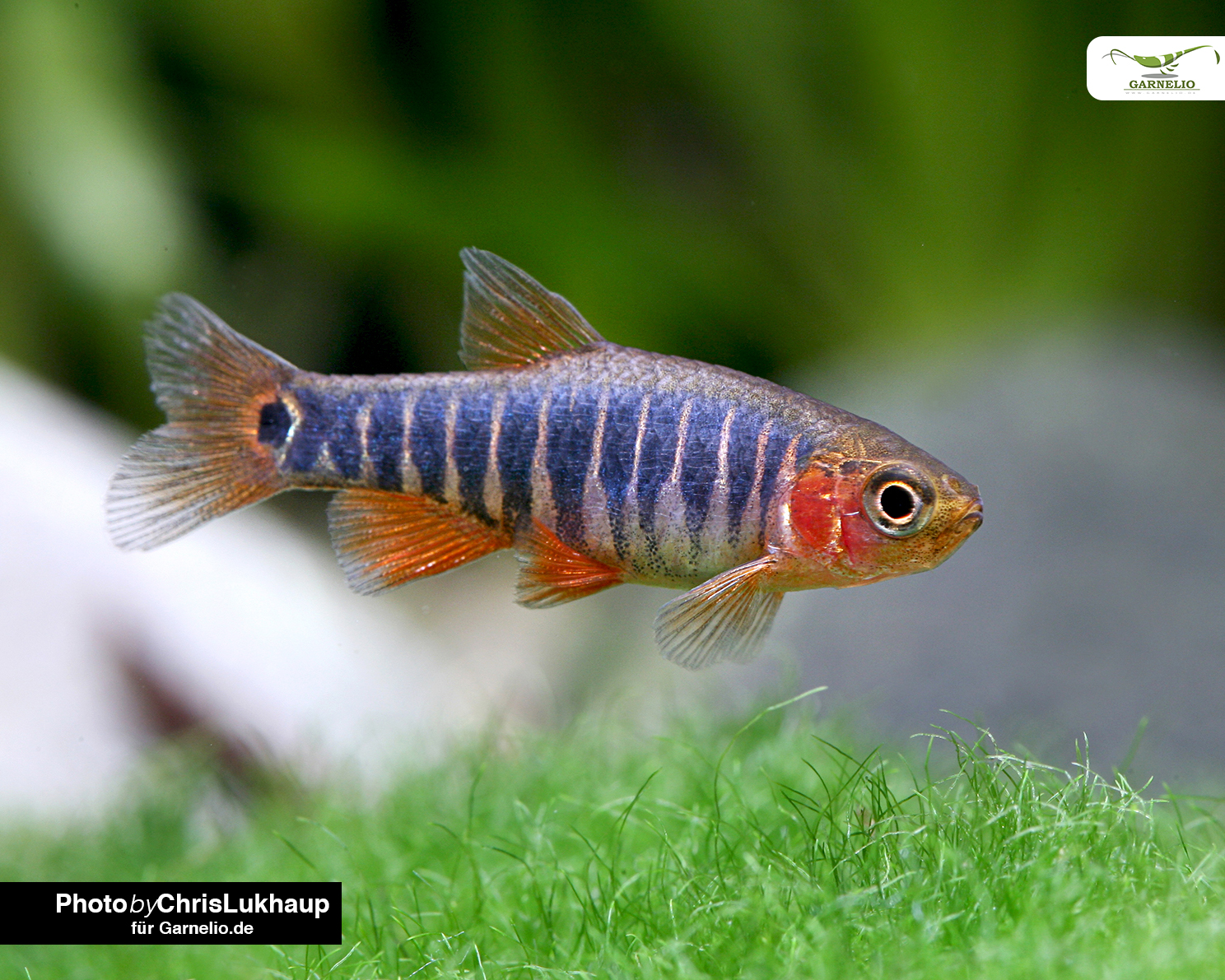
Danio margaritatus - Guinea fowl danio(Shop)
From Burma. Comparable in size, reproduction and requirements to the cross-striped dwarf danio, now and then a bit shyer. Water values: GH 5 to 20, KH 3 to 18, pH 7 to 8, temperature 18 to 25 °C.
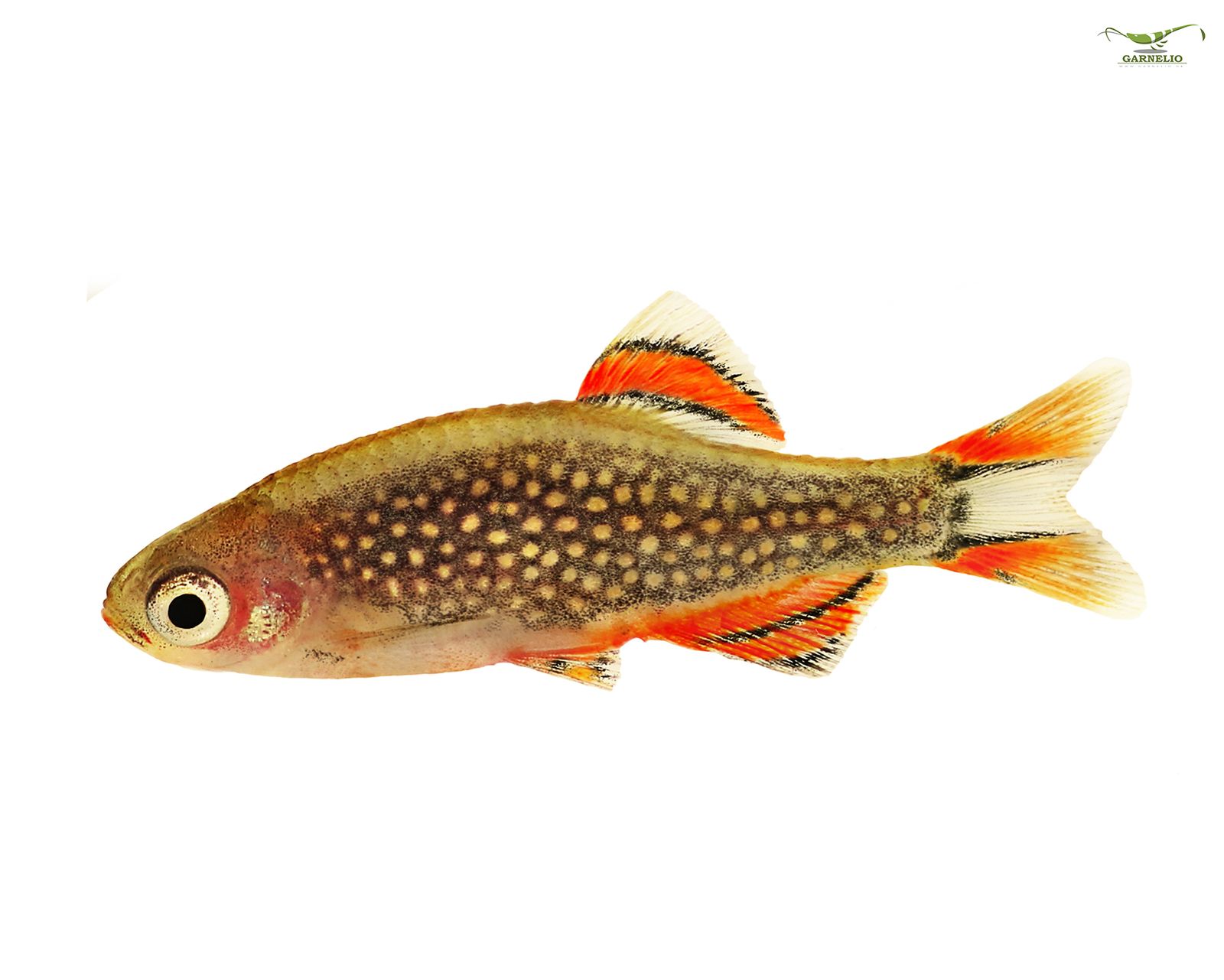
Microdevario kubotai - Green Neon Dwarf Grassbora(Shop)
The Green Neon Dwarf Grassbora is a nano fish that gets along with practically all shrimps that like acidic and soft water. The Microdevario kubotai Dwarf Grassbora, also known as Microrasbora kubotai, shimmers beautifully and fits well in aquascapes or shrimp aquariums. Omnivorous, needs very fine food. Schooling fish. Water values: GH 1°-20° dGH, KH 0-8° dKH, pH 6.0-7.2, temperature 22-26 °C.
Rasbora borapetensis - red-tailed danio, red-tailed rasbora(Shop)
The red-tailed danio, also known as red-tailed rasbora, is a very swim-friendly small danio. The mating dress of the males is colourful and very attractive. Keeping them in an aquarium with shrimps is usually unproblematic. Omnivorous, schooling fish. From 54 litres, better from 112 litres. Water values: GH 5 to 12, KH 0 to 8, pH 6 to 7.5, temperature 22 to 26 °C.
Rasbora heteromorpha - Wedge-spotted Barb(Shop)
From Southeast Asia. Grows to 4.5 cm and fits very well in aquariums from 54 litres. Can be kept in soft to medium hard water, well suited for socialisation with Amano shrimps, Neocaridina shrimps or other shrimps that reproduce well and are robust. May eat shrimp babies. Breeding difficult. Water values: GH 5 to 10, KH 0 to 5, pH 6 to 7, temperature 22 to 26 °C.
Tanichthys albonubes - Cardinalfish(Shop) / Veil Cardinalfish(Shop)
The cardinal fish is a small remaining bear fish from Southeast Asia. The schooling fish is more suitable for cool water and fits well in shrimp tanks, although young shrimp may be eaten. There is also a veil form of the cardinalfish with large fins. Breeding in a species tank is relatively easy. Water values: GH 2-20, KH 2-15, pH 6-7.5, temperature 18-22 °C.
Trigonostigma espei - Espes Keilfleckbärbling(Shop)
From Thailand and Cambodia (Southeast Asia). Grows to a maximum of 3 cm and needs a shoal. Breeding is difficult. Good with shrimps from soft water biotopes or with other small fish. Omnivorous, likes to eat small live or frozen food. For aquariums from 60 cm. Water values: GH 3 to 15, KH 0 to 10, pH 6 to 7.5, temperature 22 to 28 °C.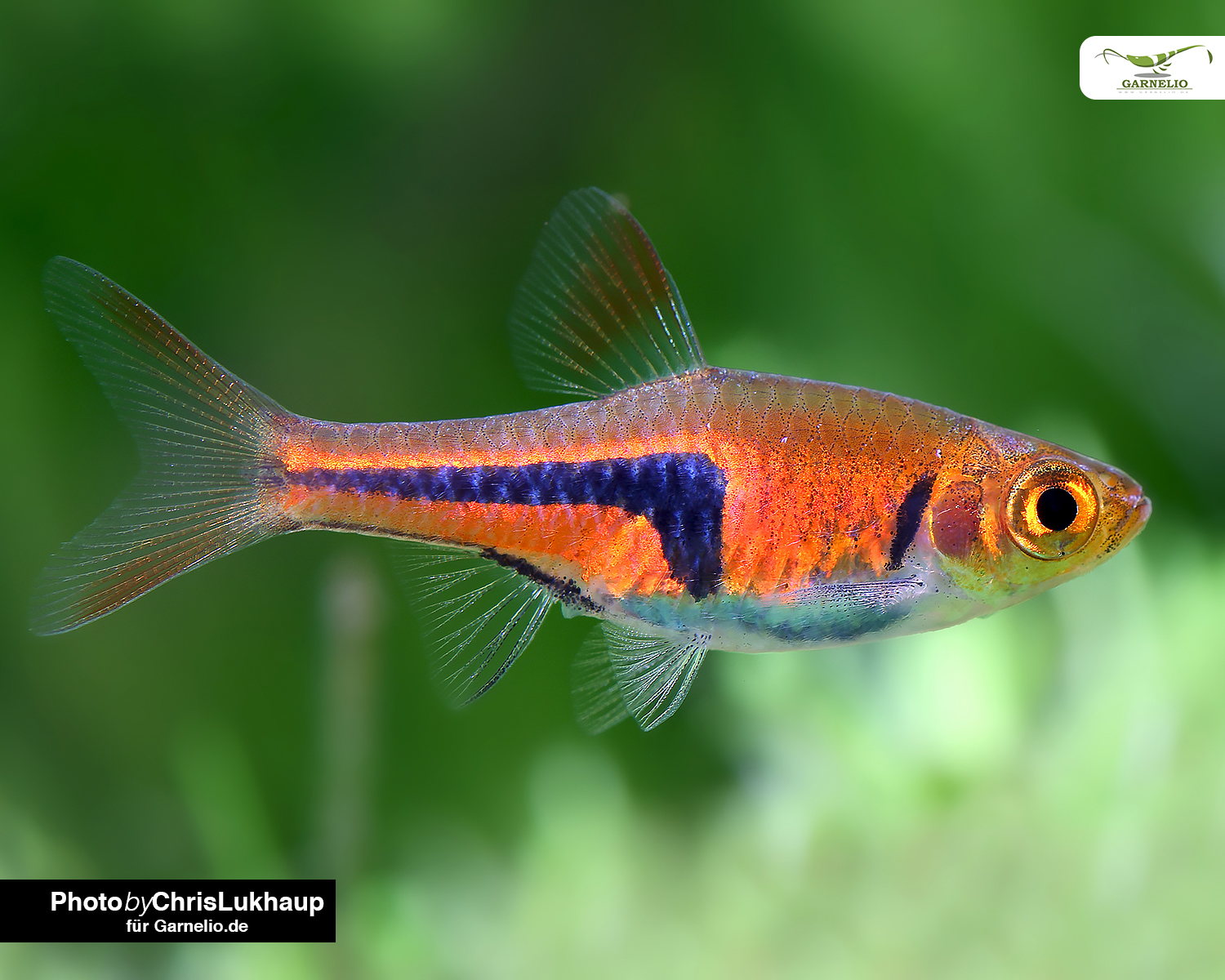
Barbs
The barbs from the genus Puntius are sociable freshwater fish from Southeast Asia. They belong to the carp fish family. They are omnivorous, eating small invertebrates as well as, depending on the species, soft plants, algae and plant remains. They should therefore only be socialised with shrimps or dwarf crayfish to a limited extent; young shrimps and freshly hatched crayfish are eaten. Breeding is possible in the aquarium, but a breeding tank is advantageous. Very soft water and good prior conditioning of the breeding pair with live food is mandatory for successful breeding of barbs.
Oliotius oligolepis (Puntius oligolepis) - Eiland barb, mother-of-pearl barb(Shop)
The eggplant barb is one of the very few barbs in aquaristics that remain very small. This sociable and, for a barb, quite peaceful aquarium fish is very lively and eager to swim despite its small size. It can be kept in an aquarium with larger shrimp, shrimp offspring tend to be eaten readily. Omnivorous, schooling fish. From 112 litres. Water values: GH 1 to 8, KH 0 to 5, pH 5.5 to 7.5, temperature 18 to 25 °C.
Puntius titteya - bitterling barb(Shop)
Bright red schooling fish from Sri Lanka. Does not usually go to plants. Socialisation with dwarf crustaceans unproblematic, especially small, freshly hatched shrimps can be eaten. Already present in aquaristics since the thirties of the last millennium. Water values: GH 2-20, KH 6-15, pH 6.5-7, temperature 24-27 °C.
Growth-eating catfishes
Among the algae-eating catfishes there are not many species that stay small and fit into aquariums up to 54 litres. Often there is not enough algae in small tanks, so you should keep a close eye on the animals and feed them if necessary. Some growth-eating catfish like to take some frozen food from time to time, although they are actually classified as herbivores. Wooden roots to grate are very important for these catfish; they need the roughage for a well-functioning digestion.
Otocinclus sp. - ear lattice catfish(Shop)
From South America. 2-3 cm large group fish, with at least 5-10 conspecifics. Goes well with shrimps and peaceful small aquarium fish. Breeding in the aquarium is almost impossible. Eater of growth, may need to be fed with catfish sticks or over-brooded vegetables. Water values: GH 2 to 18, KH 3 to 16, pH 6 to 8, temperature 20 to 28 °C.
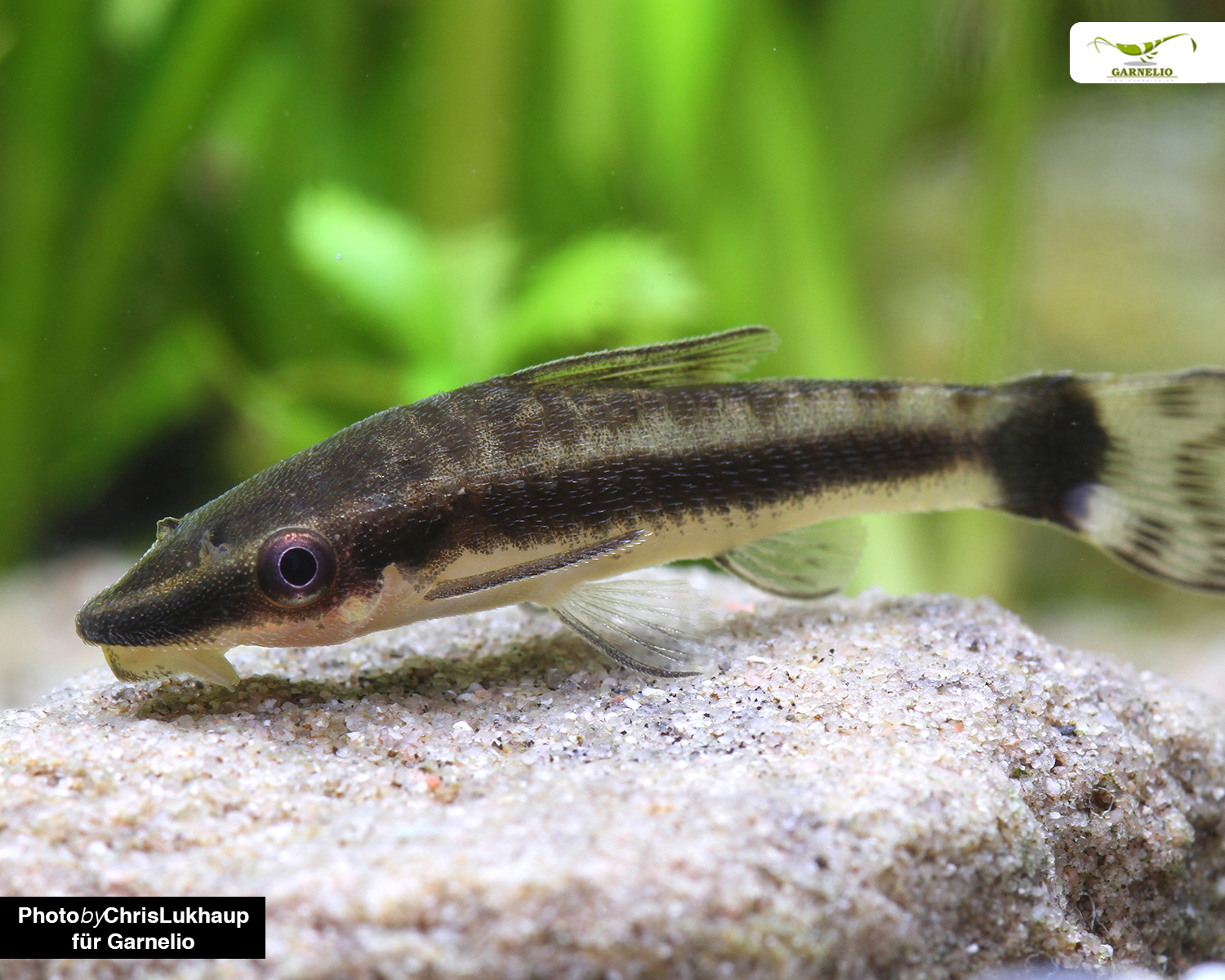
Cory catfish
Armoured catfish eat almost no growth, they are predominantly carnivores. This should be taken into account when feeding them! Nevertheless, especially the small armoured catfish species are not dangerous for shrimps, they rather eat worms and insect larvae. Corys are intestinal breathers and need free access to the water surface. Breeding these egg layers in the aquarium is possible and considered relatively easy.
Corydoras hastatus - Sickle Spot Catfish
From the Amazon region in South America. Grows to about 3.5 cm and likes larger groups. Not a pure bottom dweller. Fits well in a shrimp aquarium and also with other small fish. Breeding in the aquarium is relatively easy. Water values: GH 3 to 15, KH 0 to 12, pH 6 to 7.5, temperature 23 to 26 °C.
Corydoras pygmaeus - dwarf armoured catfish(shop)
From the Amazon region (South America). Similar to Corydoras hastatus in behaviour and husbandry, but remains somewhat smaller at approx. 3 cm.
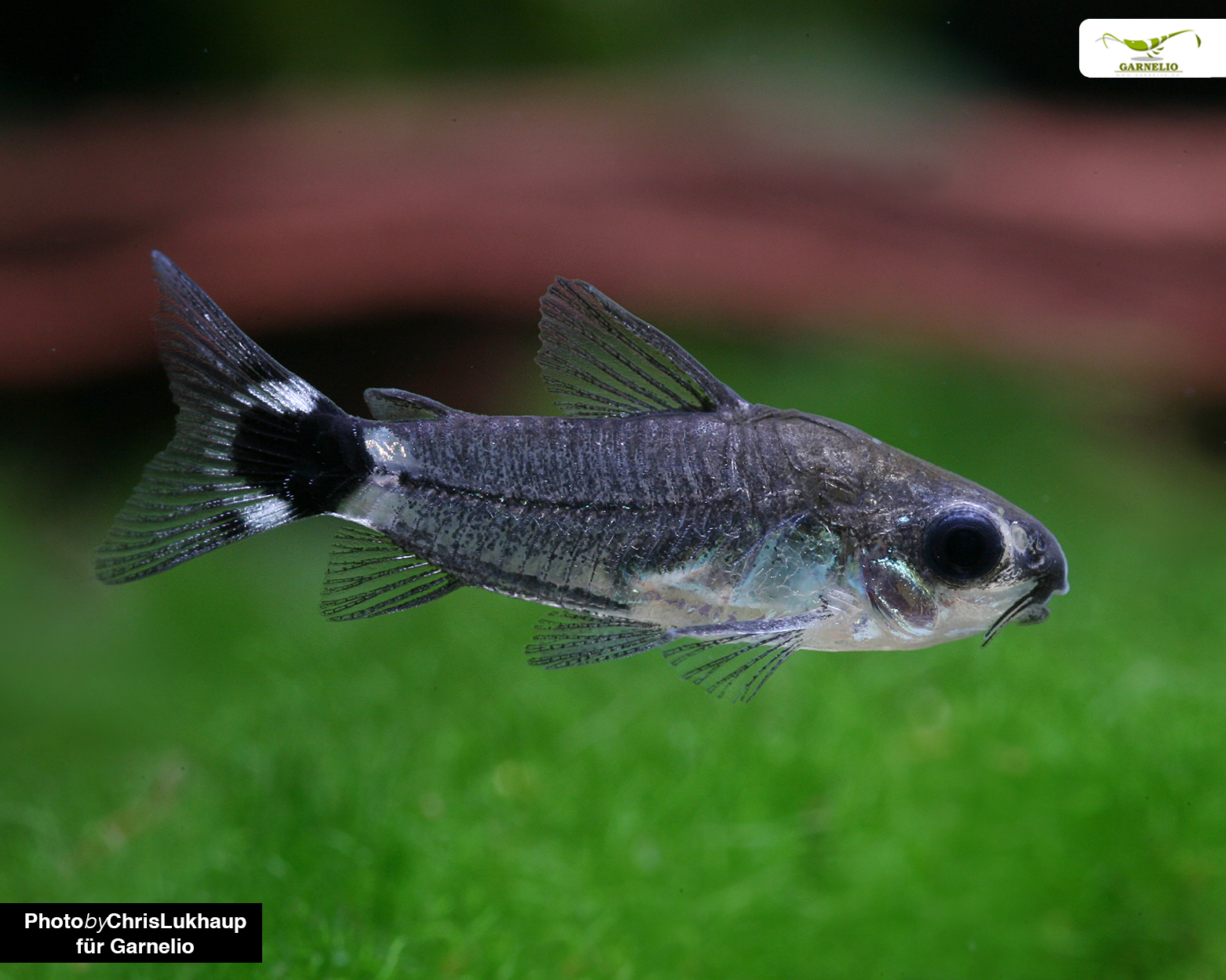
Corydoras panda - Panda Corydoras panda
From South America. Up to 5 cm long, peaceful schooling fish, does not actively chase shrimps and can be socialised well with them, as well as with other peaceful fish, ideal for community aquariums. Rather bottom oriented. Easy to breed. Water values: GH 2 to 20, KH 2 to 10, pH 6 to 7.8, temperature 22 to 26 °C.
Tetra
Tetras typically come from South America. These lively group fish (a shoal size of at least 10 is recommended) do well in somewhat longer aquariums. Many tetras do not like it very bright and are grateful for floating plants as well as dense marginal planting and still some swimming space. Breeding in the aquarium is difficult - the adult fish are spawn predators and also attack the offspring. In addition, many tetras need very soft and slightly acidic water as well as a rather dark aquarium for breeding. Tetras are omnivores that like to nibble on algae or vegetables as well as frozen and live food. Flake food for omnivorous ornamental fish is a good addition to the diet. Tetras are only suitable to a limited extent for socialising with shrimps, they eat shrimps that are small enough to fit into their mouths. Here, preference should be given to very well reproducing species of the genus Neocaridina or Sulawesi Island shrimp or shrimp that grow large, such as Amano shrimp. The fast tetras can also live together with peaceful dwarf crayfish. Most tetras are optimal fish for a classic community aquarium.
Aphyocharax anisitsi - Redfin Tetra(Shop)
From South America. Up to 5 cm long, lively, robust and swimming fish, schooling fish. From 100 litres. Omnivorous, good to keep together with dwarf crabs or robust dwarf shrimps, juveniles may be eaten. Free spawners, relatively easy to breed. Water values: GH 5-25, KH 3-10, pH 6-7.5, temperature 20-28 °C.
Carnegiella marthae - Blackwing Hatchetfish(Shop)
Unusually shaped tetra from Venezuela, with 3-4 cm a real nano fish. Lives as a schooling fish in a group of conspecifics, from 10 specimens. Surface-oriented, jumps, therefore aquarium must be covered. From 60 cm aquarium length. Breeding is possible, but not easy. Water values (keeping): GH 0 to 10, KH 0 to 5, pH 4 to 7, temperature 20 to 28 °C.
Hasemania nana - Copper Tetra(Shop)
The copper tetra is also known as Hasemania marginata. This pretty small tetra is a lively little schooling fish and therefore needs an aquarium with an edge length of 80-100 cm or more. Omnivorous. The males are clearly slimmer than the females. Water values: GH 2°-30 °dGH (ideal: 2-15 °dGH), KH 0-8° dKH, pH 6.0-8, temperature 22°-27°.
Hemigrammus bleheri - Red-headed tetra(Shop)
From South America. With a body length of up to 5 cm just about a nano fish, but due to its swimming pleasure and liveliness only recommended from 80 cm edge length. Breeding difficult, water values: GH 2 to 8, KH 0 to 7, pH 6 to 7, temperature 25 to 28 °C.
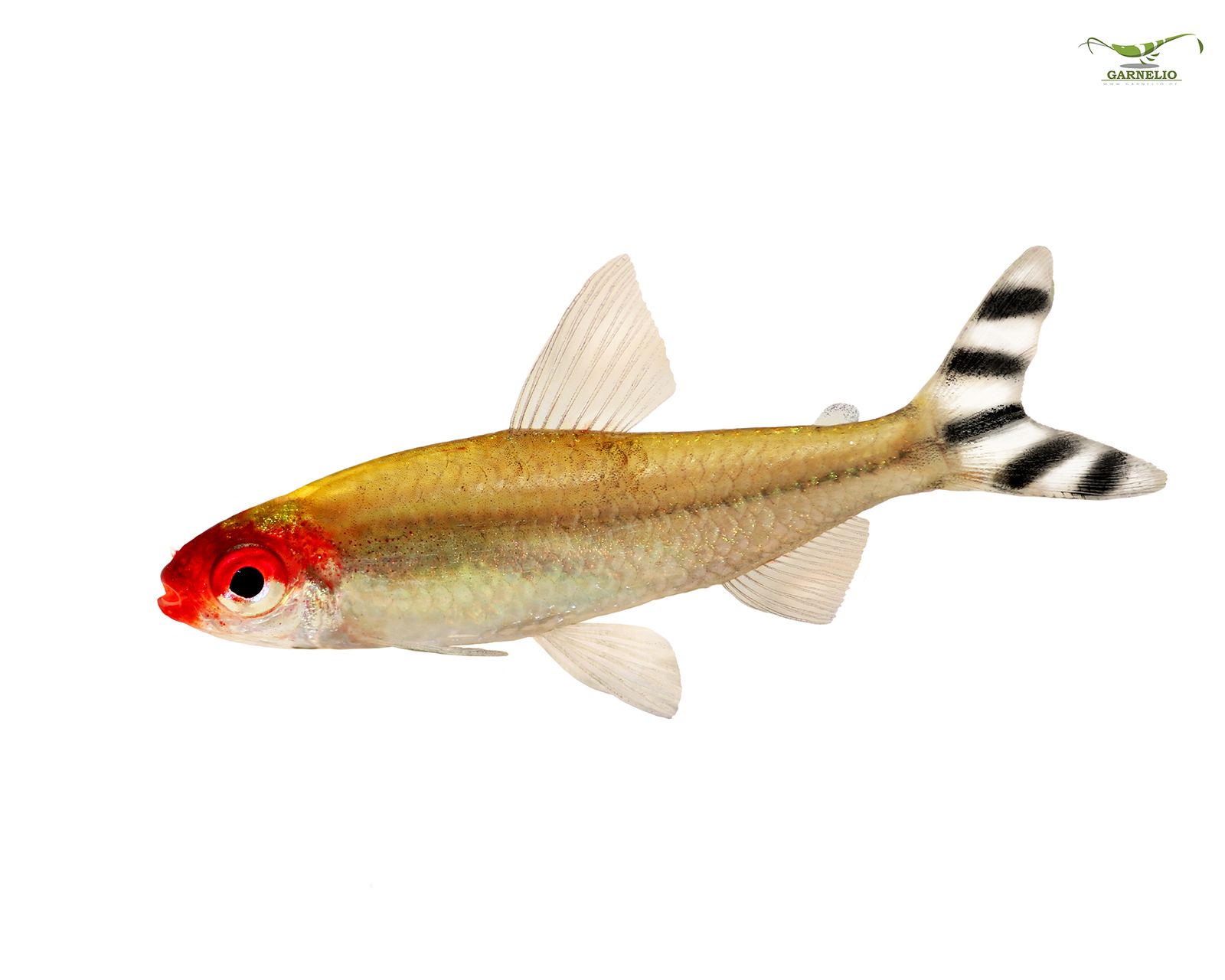
Hemigrammus erythrozonus - Glow Tetra(Shop)
From South America. Long tradition in aquaristics. 3.5-4.5 cm large omnivore. Good for aquariums from 60 cm edge length. Breeding is difficult. Water values: GH 2 to 10, KH 0 to 10, pH 5 to 7, temperature 23 to 28 °C.
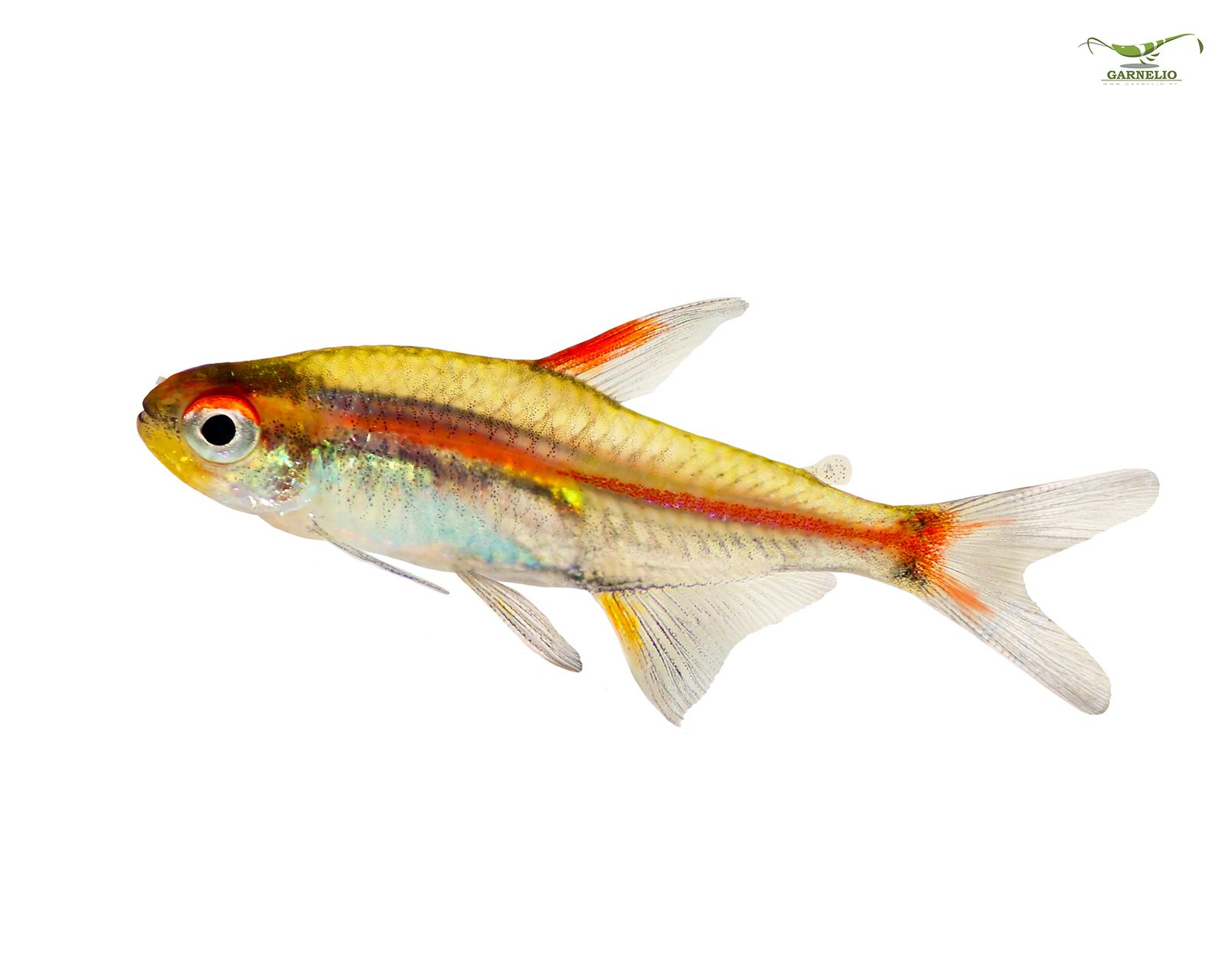
Hemigrammus ocellifer - lantern bearer, taillight tetra(Shop)
High-backed small tetra from the Amazon region, 4.5-5 cm long, for aquariums from 54 litres. Group fish from 10 specimens. Very persistent in soft to medium hard water, suitable for community or species tanks, also together with robust invertebrates. Breeding is possible, but somewhat time-consuming. Water values (keeping): GH 0-15, KH 1-10, pH 5-7, temperature 22 to 26 °C.
Hemigrammus rubrostriatus - Red stripe tetra(Shop)
The red stripe tetra is a small remaining tetra from South America. This sociable and very pretty, lively aquarium fish is quite happy to swim. It can be kept in an aquarium with dwarf shrimps, very small shrimp offspring may be eaten. Omnivore with preference for animal food, schooling fish. From 54 litres, better from 112 litres. Water values: GH 2 to 15, KH 0 to 10, pH 5 to 7, temperature 22 to 26 °C.
Hyphessobrycon amandae - Sparkling Tetra(Shop)
A very old acquaintance in aquaristics is the small sparkling tetra from South America with its body length of only 1.5-2.5 cm. Very compatible and peaceful schooling fish, can be kept well with dwarf crabs and shrimps, rather demanding in terms of breeding, needs very soft, quite acidic water. Water values: GH 2-10, GH 0-3, pH 4.5-6.5, temperature 24-28 °C.
Hyphessobrycon amapaensis - Amapa Glow Tetra(Shop)
Beautifully marked, with a body length of 2.5-3.5 cm small South American tetra. Social group fish, quite compatible. Possible with dwarf shrimps and dwarf crayfish, very small offspring will probably be eaten. Breeding possible, not very difficult. Water values: GH 0-14, KH 0-10, pH 5-7, temperature 23-28 °C.
Hyphessobrycon bentosi - Tetra, Sickle Tetra(Shop)
Formerly also known as Hyphessobrycon ornatus. From South America. Grows up to 5 cm. Colouring transparent to reddish, striking red iris colouring in the upper half, white tip in the dorsal fin. Omnivorous. Differentiation of sexes somewhat difficult, breeding in the aquarium is difficult but possible. Free spawners, spawn predators. Water values: GH 5 to 20, KH 2 to 15, pH 6 to 7.5, temperature 23 to 26 °C.
Hyphessobrycon serpae - Blood Tetra, Serpa Tetra(Shop)
From South America. Quite robust and assertive schooling fish, fits well in community tanks. Possibly fin biter if fed incorrectly. Too close keeping leads to fights in the shoal, the aquarium needs at least 120 cm edge length. Breeding relatively easy. Water values: GH 8 to 15, KH 0 to 7, pH 5.5 to 7.5, temperature 23 to 28 °C.
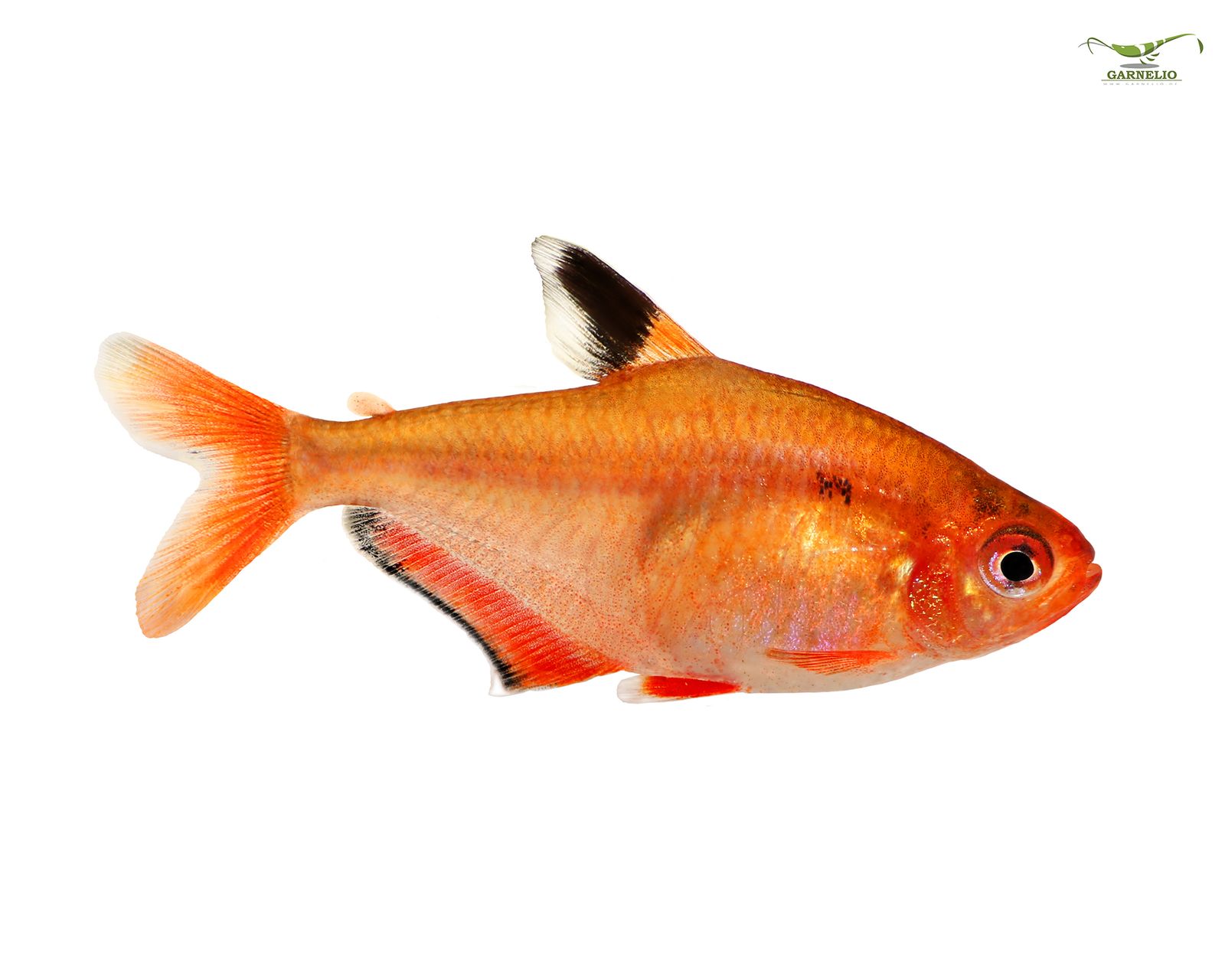
Hyphessobrycon flammeus - Red of Rio(Shop)
From Brazil / South America. Group fish, grows to 3-4 cm long, very high-backed, appears larger. Well suited for the classic community aquarium, breeding much easier than with other tetras. Water values: GH 5 to 15, KH 3 to 5, pH 6.8 to 7.5, temperature 22 to 24 °C.
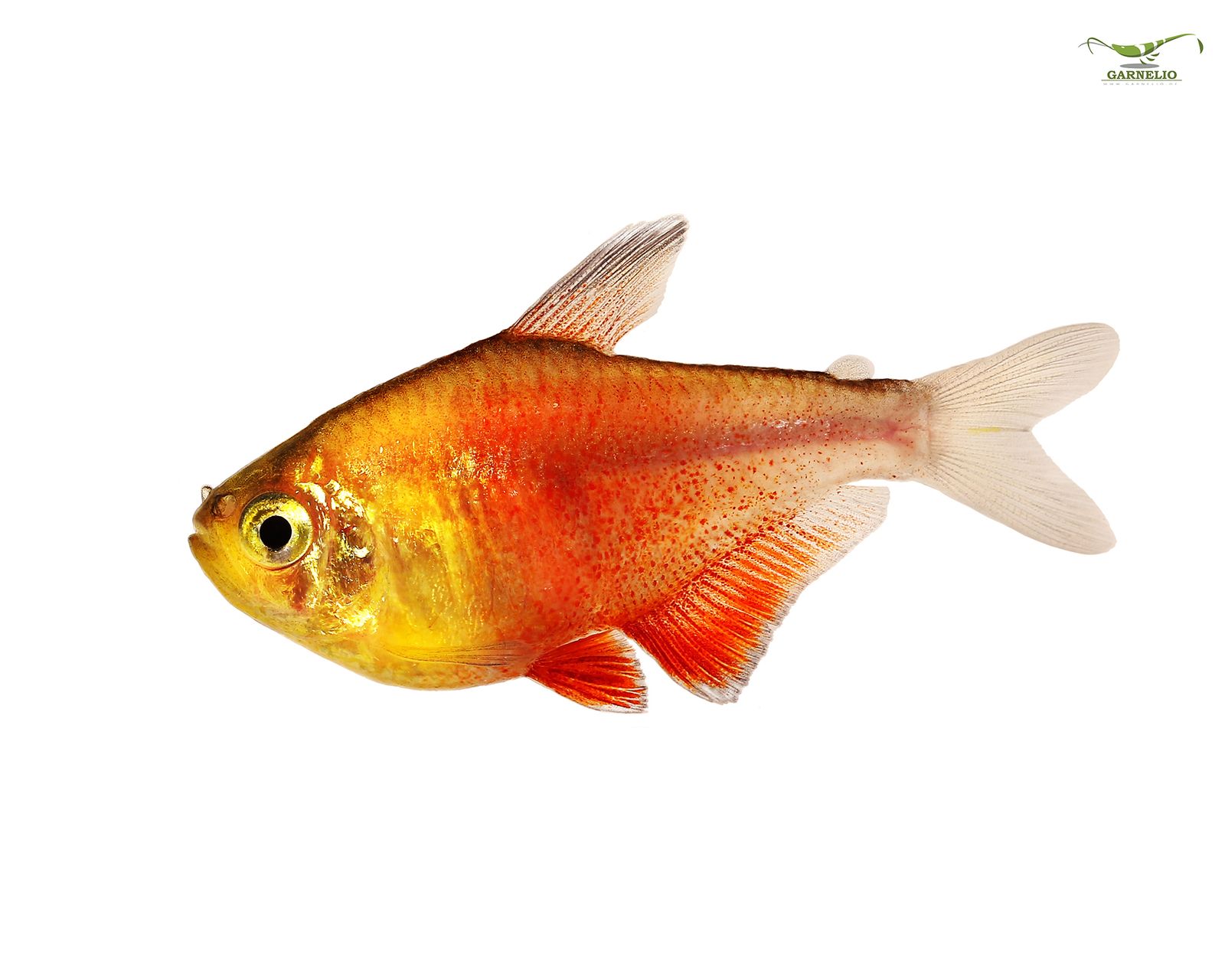
Hyphessobrycon herbertaxelrodi - Black Neon(Shop)
From South America. Up to 5 cm long, likes soft water. Different genus than the Red Neon or the Neon Tetra, so not closely related. Water values: GH 5 to 15, KH 0 to 10, pH 6 to 7.5, temperature 24 to 28 °C.
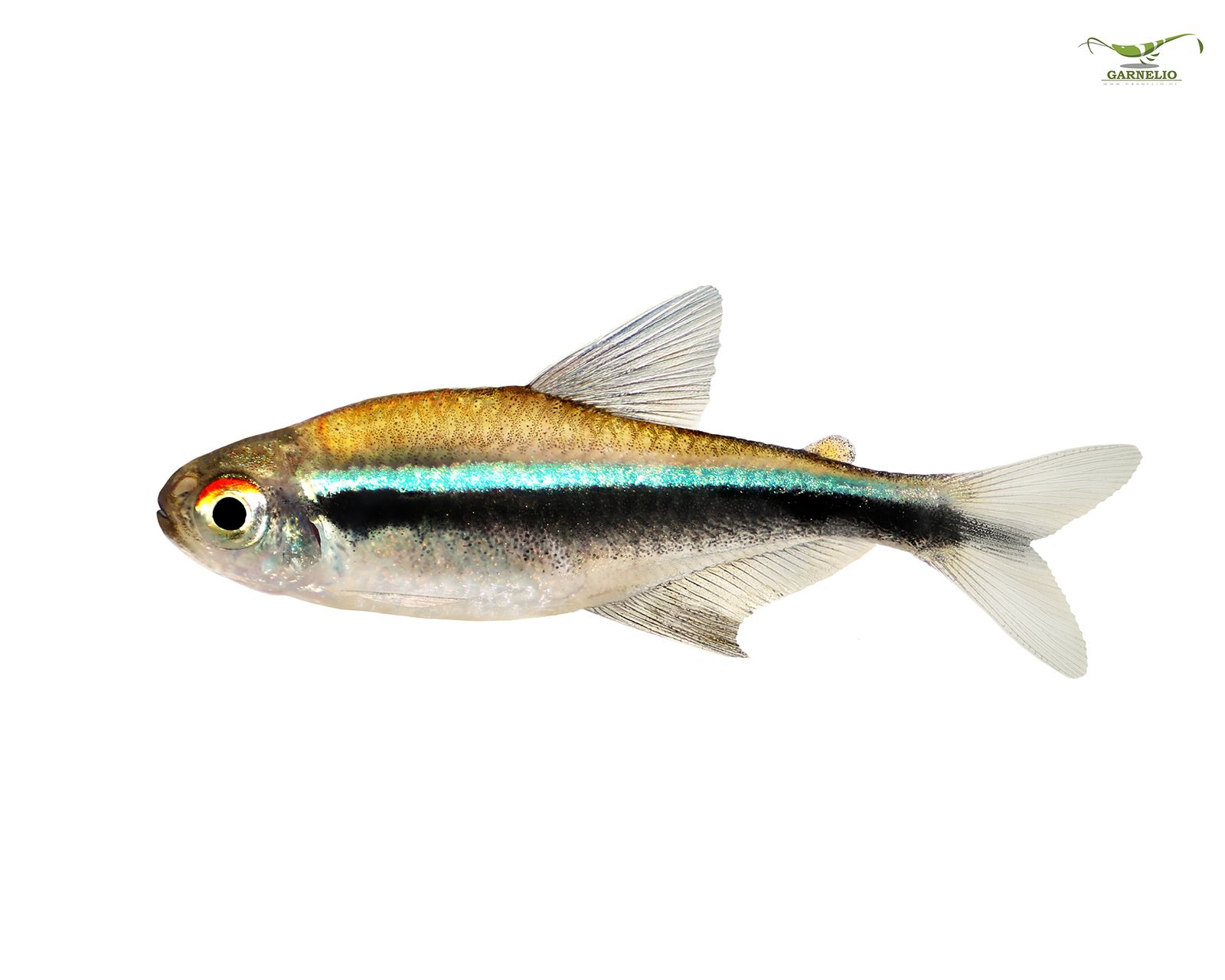
Hyphessobrycon piranga - Red Devil(Shop)
New species from Brazil, South America. Grows to only 3-4 cm. Males and females can be easily distinguished by the colour of the fins, red in the male, yellow in the female. Omnivorous. Very lively and sociable dwarf tetra, relatively easy to breed. Free spawners, spawn predators. Water values: GH 5 to 9, KH 2 to 7, pH 6 to 7.5, temperature 24 to 27 °C.
Hyphessobrycon pulchripinnis - Lemon Tetra, Fairfin Tetra(Shop)
From South America. Lively, lively schooling fish growing to 4-5 cm in length from soft water habitats. Breeding difficult. Water values: GH 3 to 8, KH 0 to 3, pH 5.5 to 6.8, temperature 24 to 27 °C.
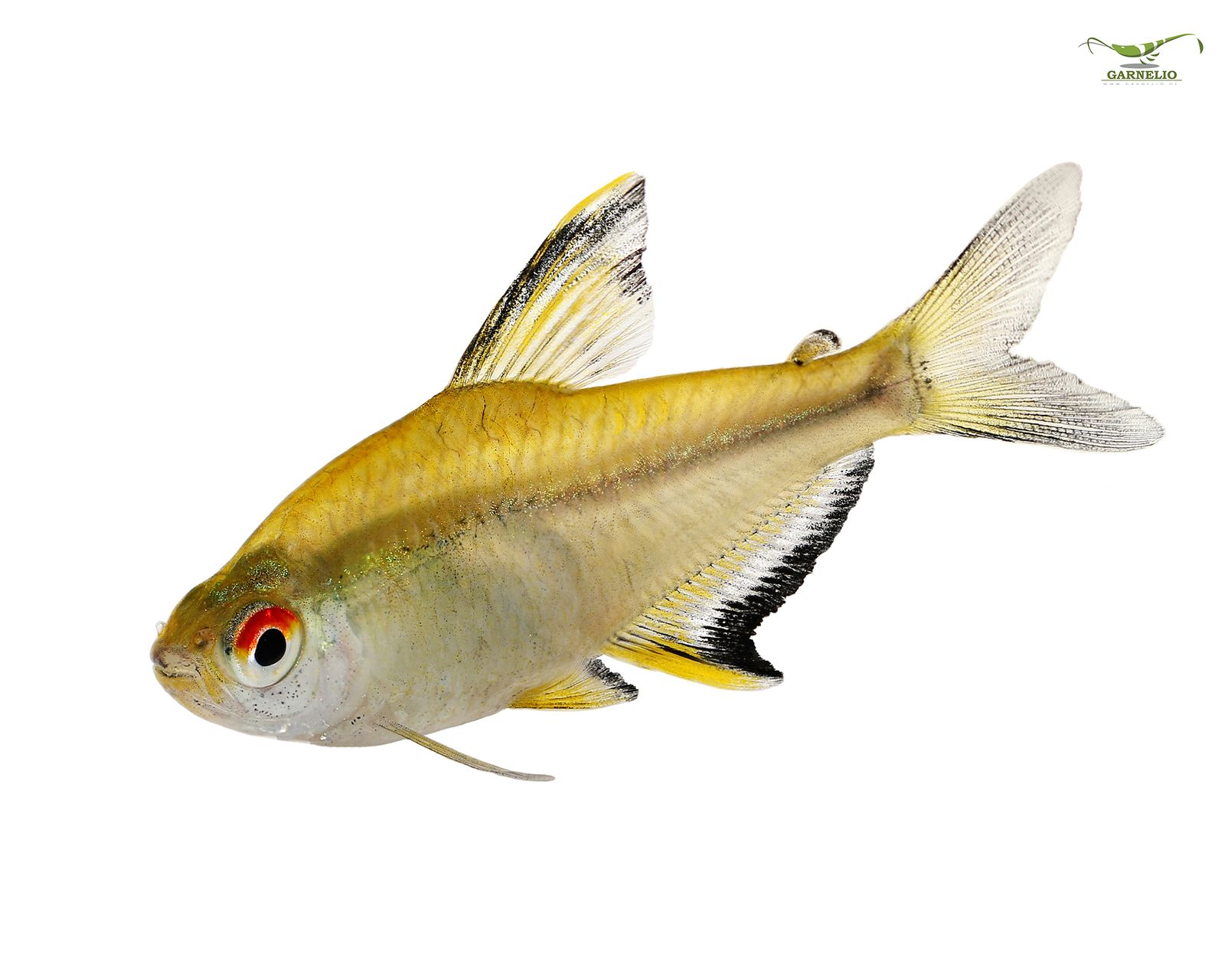
Hyphessobrycon megalopterus - Black Phantom Tetra(Shop)
From South America. Up to 4.5 cm long, high-backed tetra. Peaceful and not so strong swimming fish, schooling fish. Omnivorous, good to keep together with dwarf crabs or robust dwarf shrimps, juveniles can be eaten. Tetra typical free spawner, breeding possible in acidic soft water. Water values: GH 2-15, KH 0-6, pH 6-7.5, temperature 22-29 °C.
Inpaichthys kerri - King Tetra(Shop)
From South America. 3-5 cm long, schooling fish. Because of its swimming ability, only for fish with an edge length of 80 cm or more. Difficult to breed. Goes well with other peaceful and rather reserved aquarium fish. For soft water. Water values: GH 3 to 15, KH 0 to 12, pH 5.5 to 7, temperature 24 to 27 °C.
The king tetra is also available in the "Super Blue" variety - see picture below -(shop) and a golden colour form(shop).
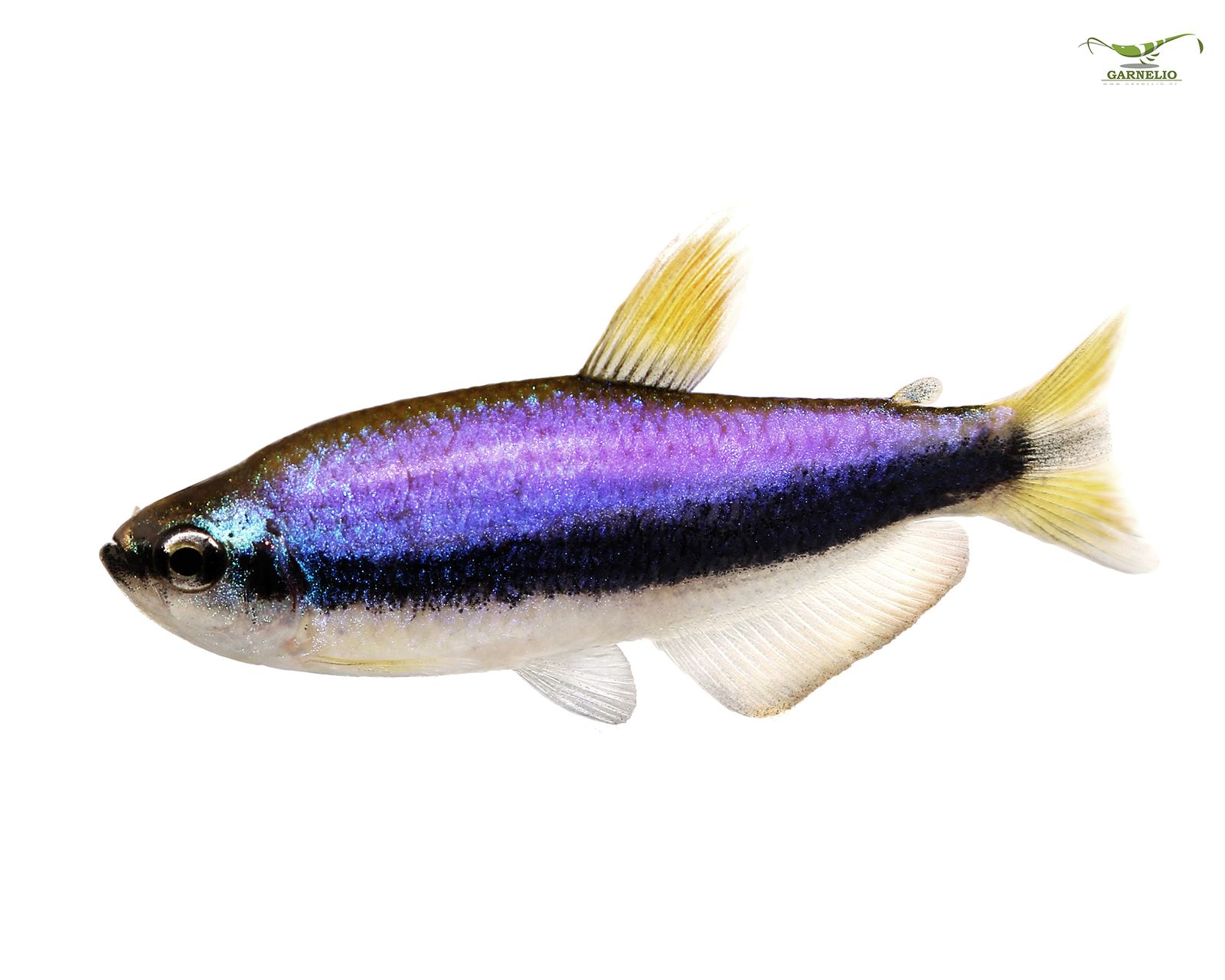
Knodus borki - Blue Perusal Tetra(Shop)
The Blue Perusal was known as Boehlkea fredcochui, but was redescribed as Knodus borki in 2008. This pretty blue-silver, rather small remaining tetra is a very swimming and lively schooling fish and therefore needs an aquarium with an edge length of 80-100 cm or more. Omnivorous. The males are more colourful and clearly slimmer than the females. Schooling fish. Water values: GH 3°-15° dGH, KH 0-8° dKH, pH 6.5-7.5, temperature 25-28 °C.
Nannostomus marginatus - Dwarf Tetra(Shop)
From South America. Rather calm small soft water fish with 3.5-4 cm body size. Schooling fish. Possible from 54 litres, also in fish company. Breeding relatively difficult. Water values: GH 3 to 15, KH 0 to 10, pH 5 to 7.5, temperature 22 to 30 °C.
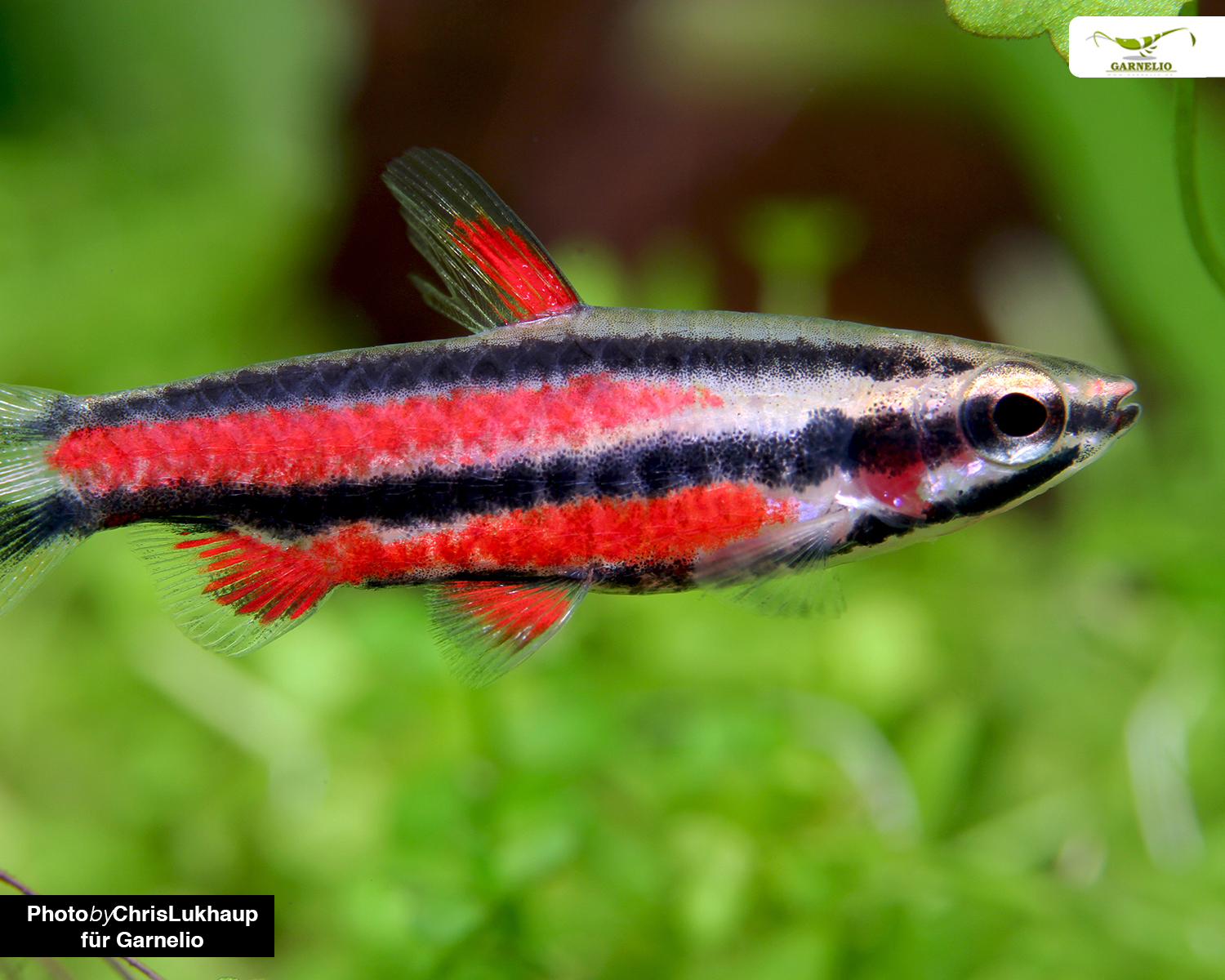
Nematobrycon palmeri - Emperor Tetra(Shop)
From Colombia / South America. Beautiful colours and shapes, 4-5 cm body size. Peaceful, calm schooling fish, ideal for community aquariums from 54 litres. Good for breeding. Water values: GH 2 to 10, KH 0 to 10, pH 5 to 7, temperature 23 to 27 °C. There is also a golden version(shop) and a black version(shop) of the emperor tetra, both of which you can also buy at Garnelio.
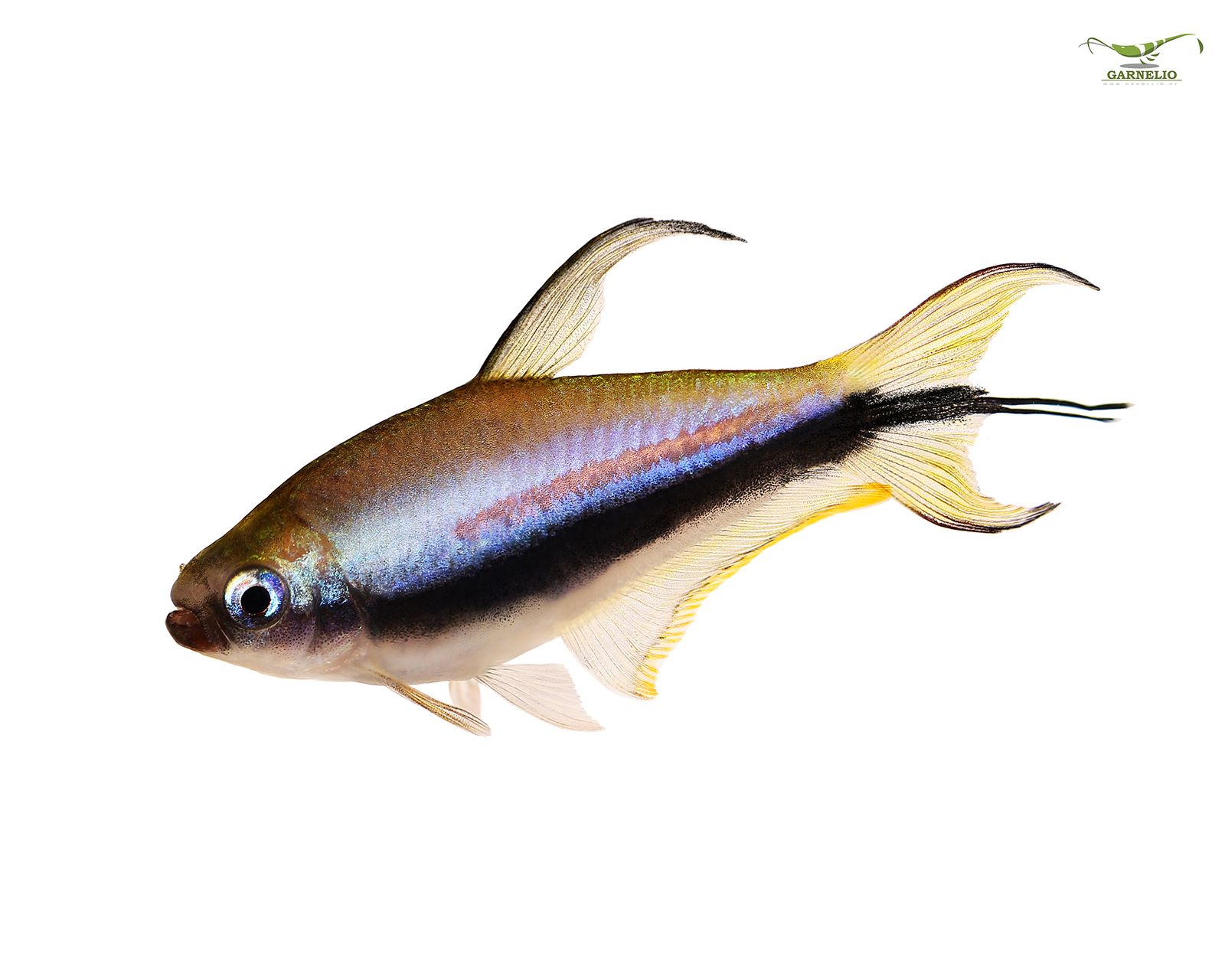
Paracheirodon axelrodi - Red Neon(Shop)
Classic from South America and with 3-5 cm just about a nano fish. Needs a school of conspecifics, from 10 specimens. Very fond of swimming, therefore only from 60, better from 80 cm aquarium length. Breeding is feasible, but complicated. Water values (keeping): GH 3 to 10, KH 0 to 5, pH 5 to 7.5, temperature 22 to 30 °C.
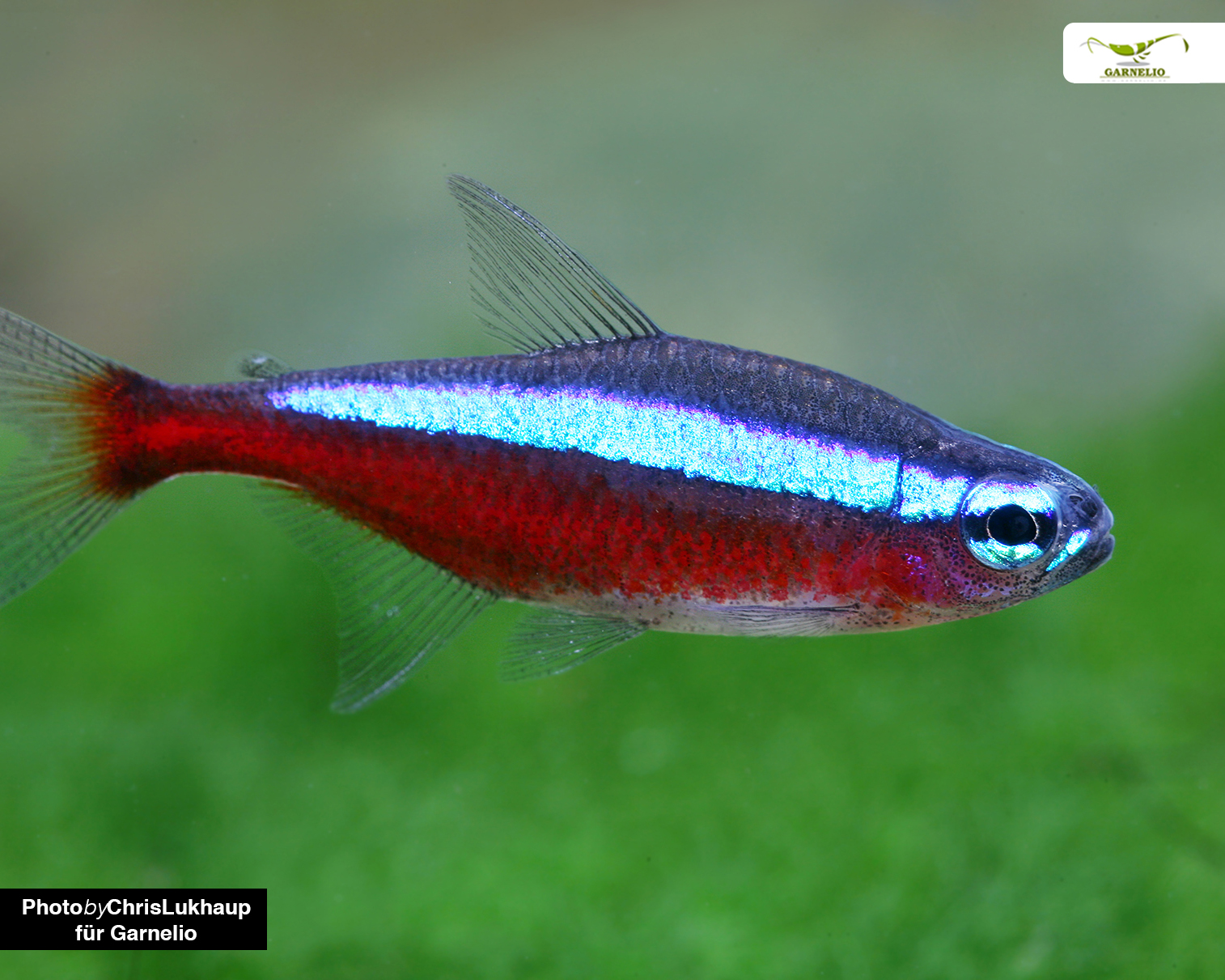
Paracheirodon innesi - Neon tetra gold(Shop)
This gold-coloured breeding form of the otherwise rather silvery Neon Tetra from the South American tropics is a swarming fish that remains small, with a body length of only approx. 3.5-4 cm. Breeding rather difficult. Socialisation with robust dwarf shrimps possible, offspring may be eaten. Water values: GH 2-20, KH 0-8, pH 5-7.5, temperature 20-27 °C.
Paracheirodon simulans - Blue Neon(Shop)
From the South American tropics, soft water fish. 3-3.5 cm long group fish, shoal from 10 animals. From 60 cm edge length. Breeding is considered very complicated. Water values: GH 3 to 10, KH 0 to 5, pH 5 to 7.5, temperature 22 to 30 °C.

Pristella maxillaris - Star-spotted tetra(Shop)
From South America, aquarium fish with a long tradition in aquaristics. Up to 4.5 cm long, beautifully marked tetra. Peaceful fish that likes to swim, schooling fish. From 100 litres. Omnivorous, good to keep together with dwarf crabs or robust dwarf shrimps, juveniles can be eaten. Tetras are typical free spawners, breed in soft water with an acidic to neutral pH value. Water values: GH 5-20, KH 3-10, pH 6-7.5, temperature 24-28 °C.
Gobies
Very few gobies remain small enough to be kept in small aquariums. Gobies are relatively territorial, but want the presence of conspecifics and should not be kept alone. They are carnivores and should not be fed conventional flake food. Frozen food and live food are definitely the best choice here. Due to their wide mouths, even smaller goby species are not safe from shrimp up to an astonishing size, so they should only be kept with larger shrimp or with well-reproducing species such as Neocaridina. Gobies practice brood care, yet not all species are easy to breed. Gobies should not be kept together with crayfish, as they occupy the same aquarium area and would be more or less defenceless against the hard crayfish claws.
Brachygobius xanthozona - Goldring Goby(Shop)
From China. Grows to 3-5 cm and likes hard water. Pure carnivore. From 60 cm edge length. For rather hard water. Socialisation with other fish in the upper water layers can work, limited compatibility with shrimps. Water values: GH 8-30, KH 3 to 25, pH 7-8.5, temperature 26 to 30 °C.
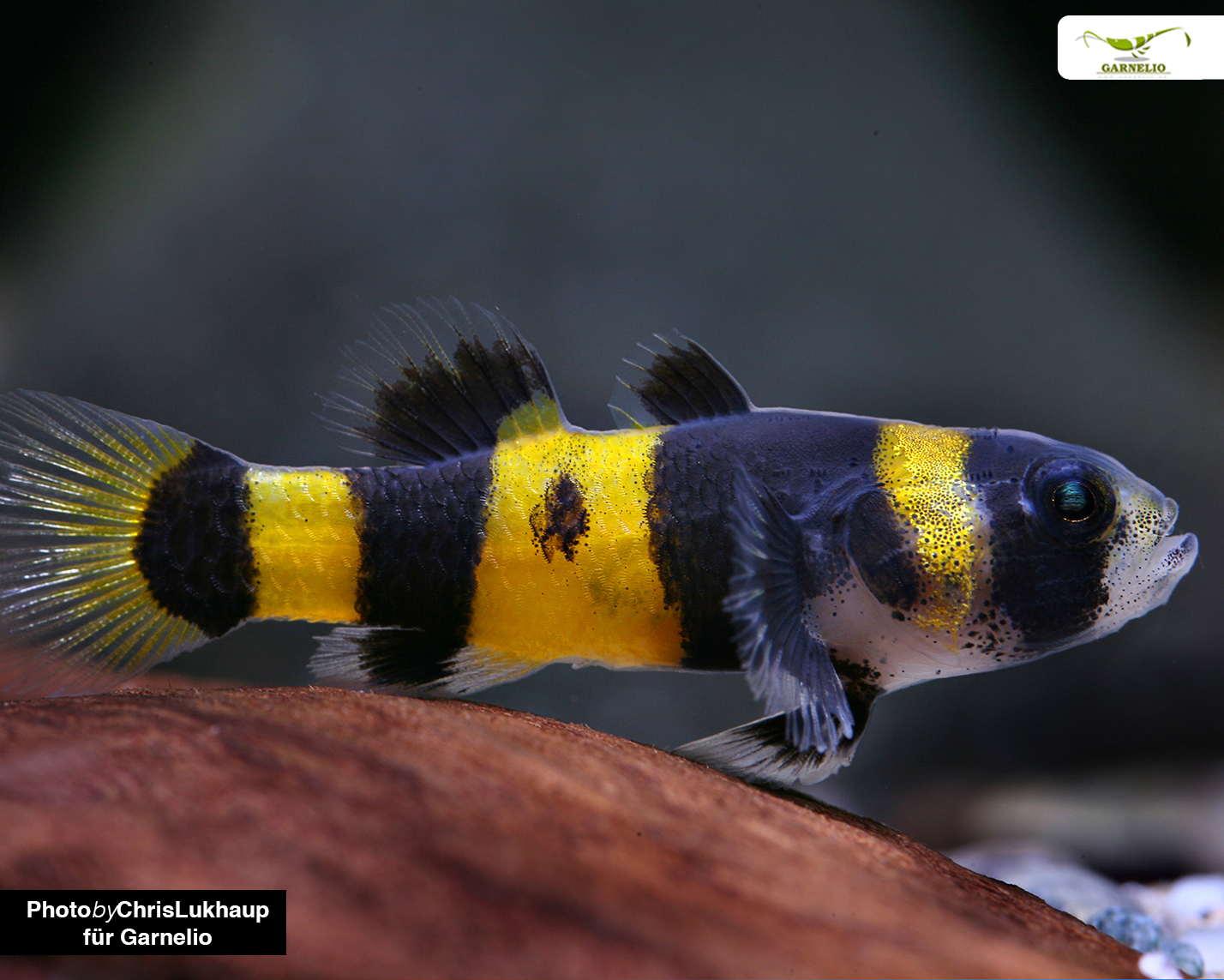
Pufferfish
Pufferfish are common in freshwater, brackish water and marine water. What they all have in common is their funny, very roundish shape and their strikingly large eyes. In case of danger, they can inflate and then look very impressive. However, as inflating is very stressful for the fish, you should never provoke them to do so. Pufferfish have special teeth that are fused into two ridges in the upper jaw and two ridges in the lower jaw. These teeth are constantly growing back and are used to crack food - snails and mussels. They depend on hard-shelled food - they will also eat soft food such as mosquito larvae, but in the long run their teeth become too long and they starve to death. Dwarf shrimps and crayfish are also among their prey, along with snails and mussels, so socialisation should not take place. Pufferfish are exceptionally agile and manoeuvrable and can swim backwards as well as forwards. Please check carefully before buying if you are looking at a species that can cope in freshwater. Unfortunately, brackish pufferfish do not grow old in freshwater.
Carinotetraodon travanocoricus - Pea Pufferfish(Shop)
The pea pufferfish is a cute tiny fish that is really popular as a snail eater in aquaristics. With only 2-3 cm and with its really big eyes, the spherical little pea is a very nice looking fish in the aquarium. Keep in a group of at least 6 animals, preferably in a species tank. Fins twitchers, not to calm fish, not to shrimps and not to dwarf crabs. Breeding possible. Cannot be accustomed to dry food, food specialist! Needs live snails. Water values: GH 5-20, KH 8-15, pH 7.2-8.5, temperature 24-27 °C.
